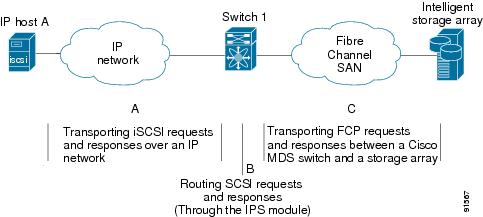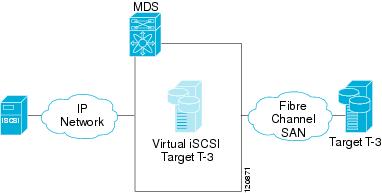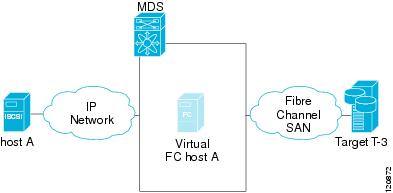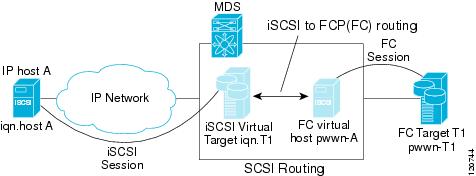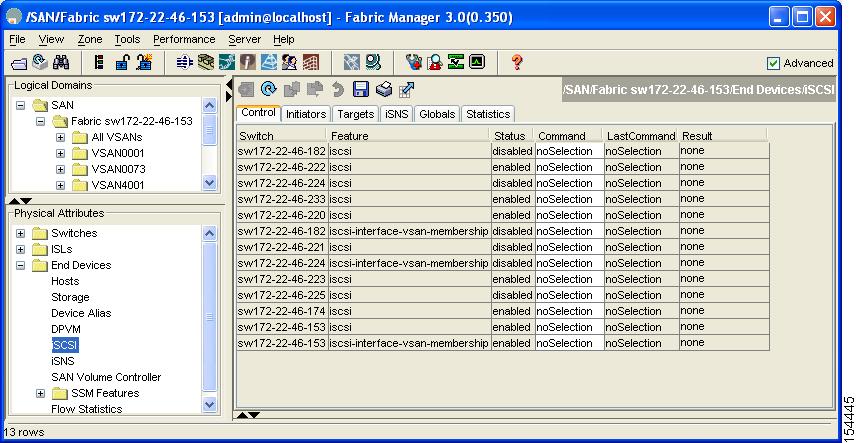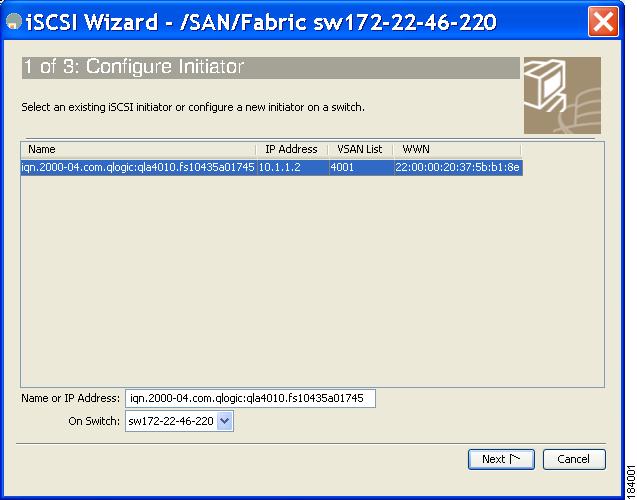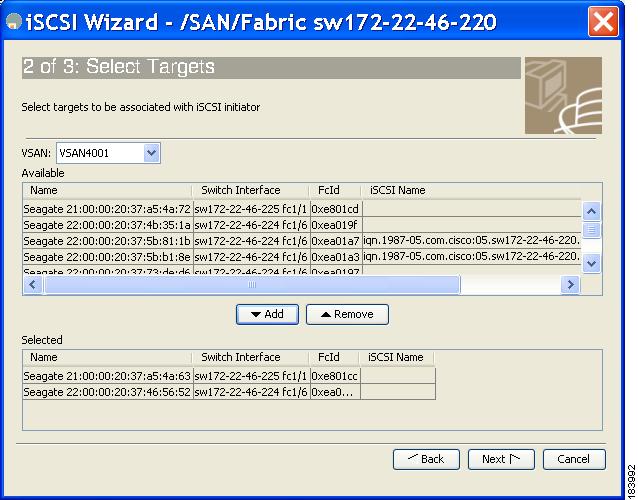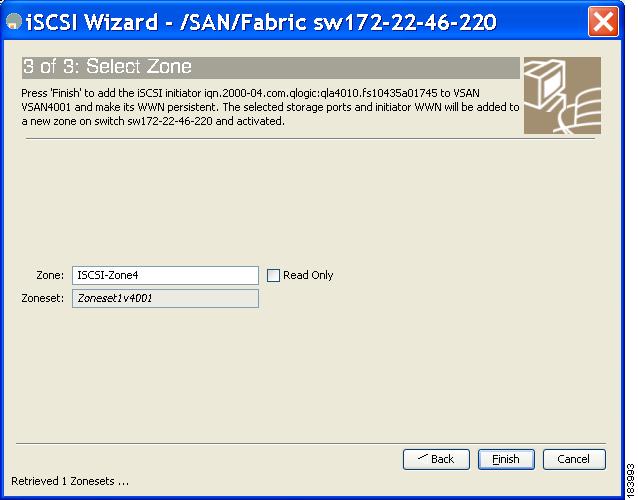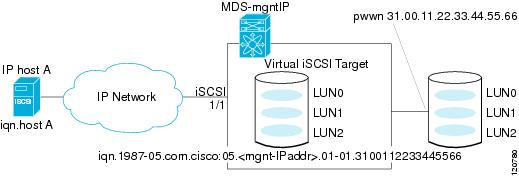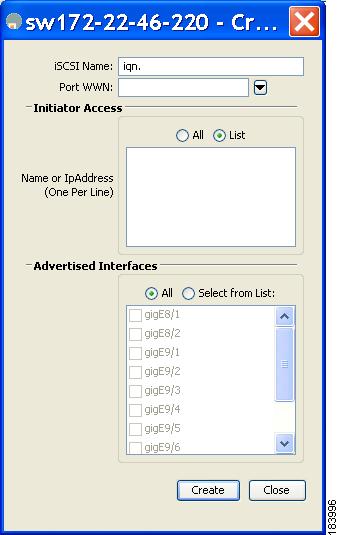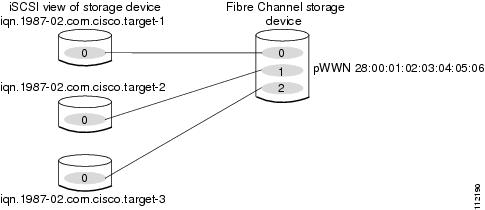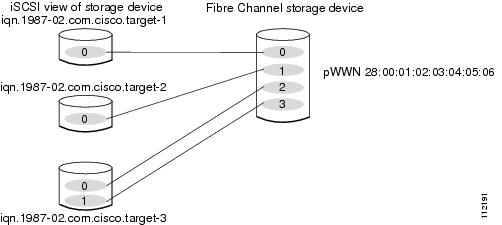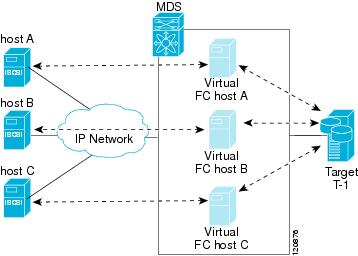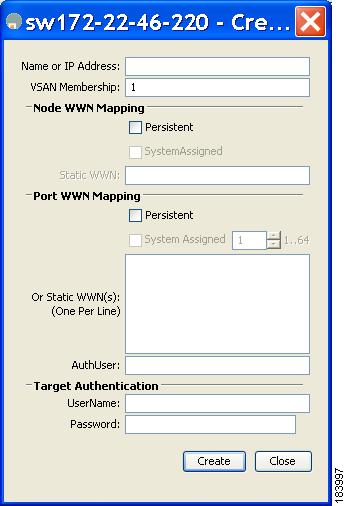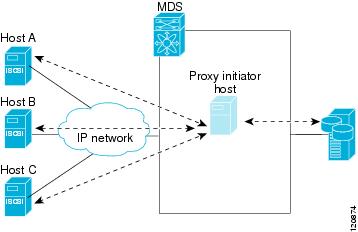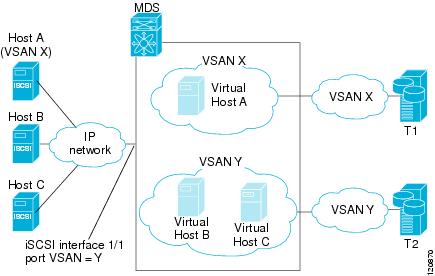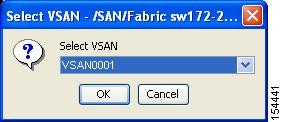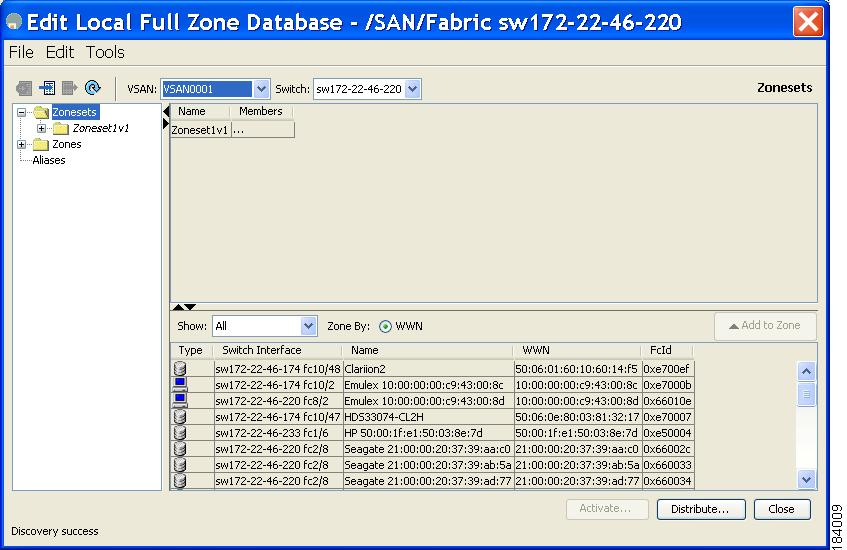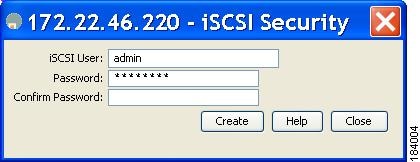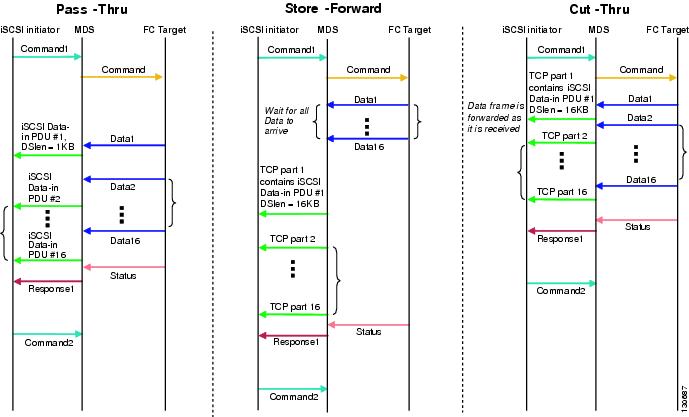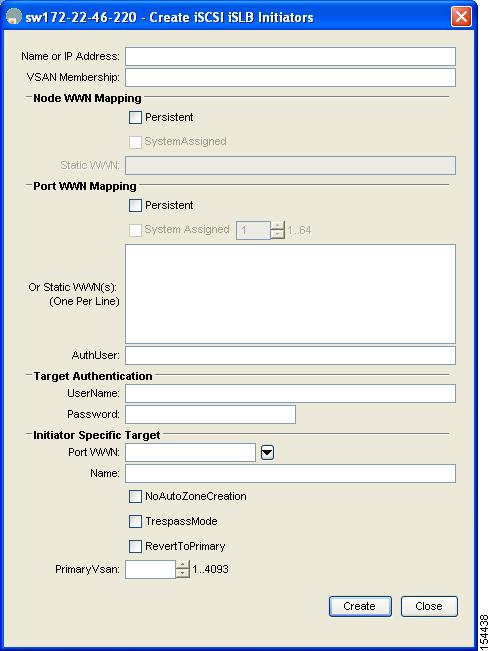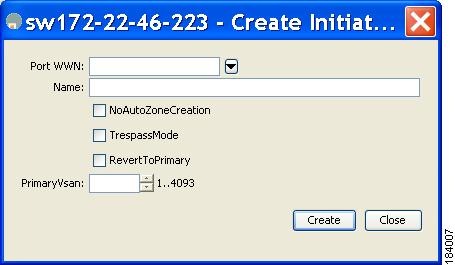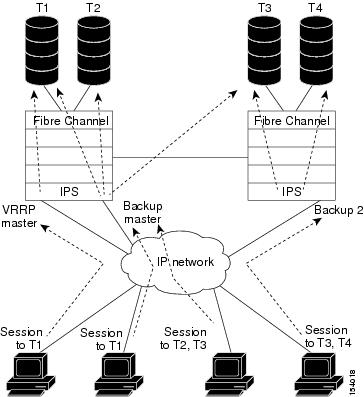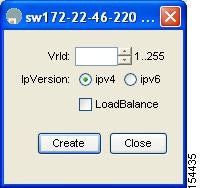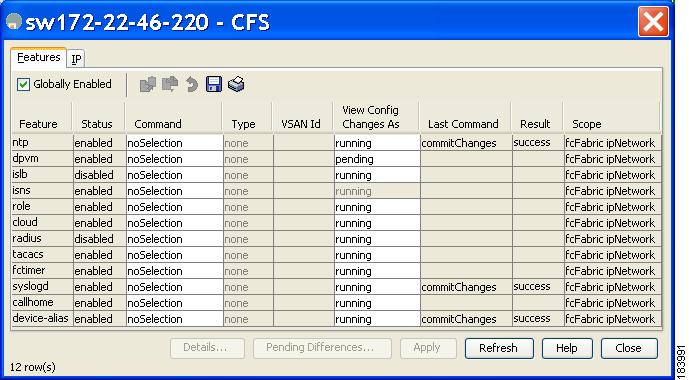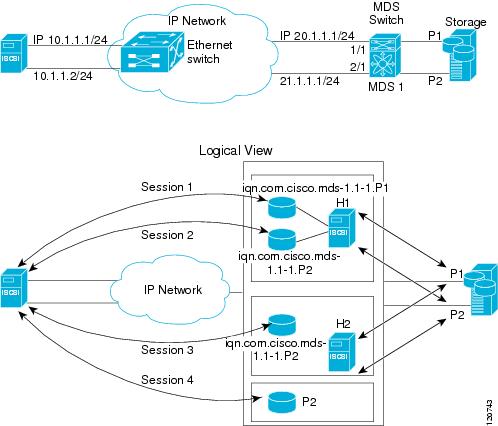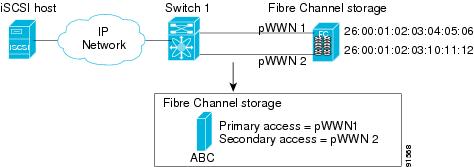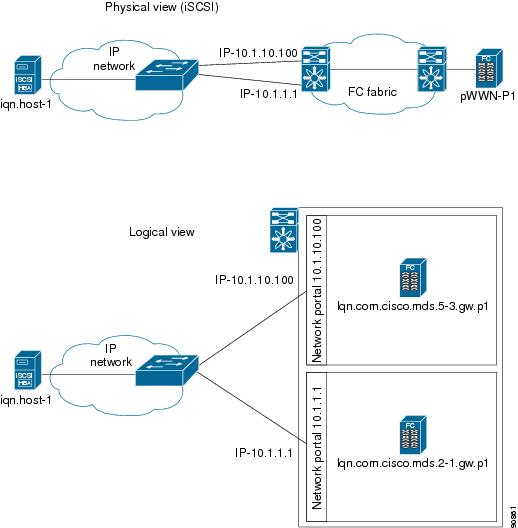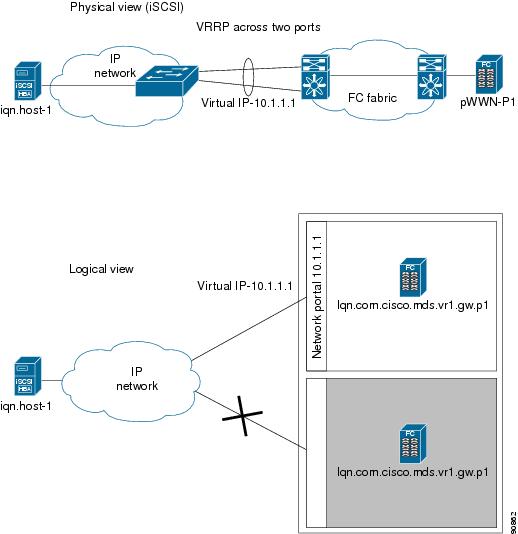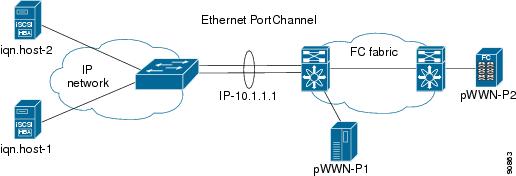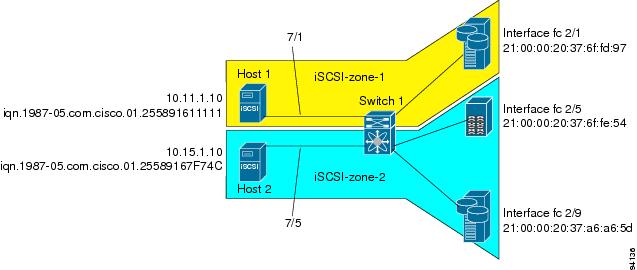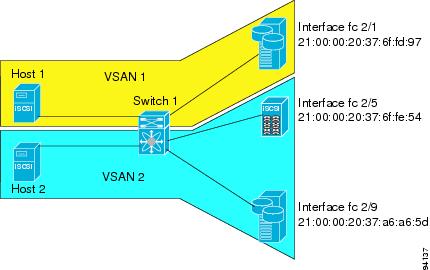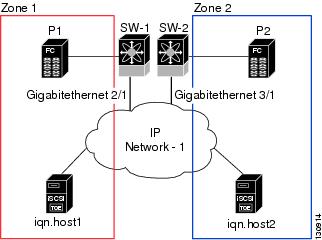

-
Cisco MDS 9000 Family Fabric Manager Configuration Guide, Release 3.4(1a)
-
Index
-
New and Changed Information
-
Preface
- Getting Started
- Installation and Switch Management
- Switch Configuration
-
Fabric Configuration
-
Configuring and Managing VSANs
-
SAN Device Virtualization
-
Creating Dynamic VSANs
-
Configuring Inter-VSAN Routing
-
Configuring and Managing Zones
-
Distributing Device Alias Services
-
Configuring Fibre Channel Routing Services and Protocols
-
Dense Wavelength Division Multiplexing
-
Managing FLOGI, Name Server, FDMI, and RSCN Databases
-
Discovering SCSI Targets
-
Configuring FICON
-
Advanced Features and Concepts
-
-
Security
-
Configuring FIPS
-
Configuring Users and Common Roles
-
Configuring SNMP
-
Configuring RADIUS and TACACS+
-
Configuring IPv4 Access Control Lists
-
Configuring Certificate Authorities and Digital Certificates
-
Configuring IPsec Network Security
-
Configuring FC-SP and DHCHAP
-
Configuring Port Security
-
Configuring Fabric Binding
-
- IP Services
- Intelligent Storage Services
- Network and Switch Monitoring
- Traffic Management
- Troubleshooting
-
Launching Fabric Manager in Cisco SAN-OS Releases Prior to 3.2(1)
-
Cisco Fabric Manager Unsupported Feature List
-
Interface Nonoperational Reason Codes
-
Managing Cisco FabricWare
-
Configuration Limits for Cisco MDS SAN-OS Release 3.1(x) and 3.2(x)
-
Table Of Contents
About iSCSI Configuration Limits
Presenting Fibre Channel Targets as iSCSI Targets
iSCSI Virtual Target Configuration Examples
Presenting iSCSI Hosts as Virtual Fibre Channel Hosts
Example of VSAN Membership for iSCSI Devices
Advanced VSAN Membership for iSCSI Hosts
Fibre Channel Zoning-Based Access Control
Restricting iSCSI Initiator Authentication
Configuring an iSCSI RADIUS Server
iSCSI Immediate Data and Unsolicited Data Features
iSCSI Interface Advanced Features
About iSLB Configuration Limits
iSLB Configuration Prerequisites
Configuring iSLB using Device Manager
Assigning WWNs to iSLB Initiators
Making the Dynamic iSLB Initiator WWN Mapping Static
Assigning VSAN Membership for iSLB Initiators
Configuring Metric for Load Balancing
Configuring iSLB Initiator Targets
Configuring and Activating Zones for iSLB Initiators and Initiator Targets
Configuring iSLB Session Authentication
About Load Balancing Using VRRP
Changing iSCSI Interface Parameters and the Impact on Load Balancing
VRRP Load Balancing Algorithm For Selecting Gigabit Ethernet Interfaces
Configuring Load Balancing Using VRRP
About iSLB Configuration Distribution Using CFS
Distributing the iSLB Configuration Using CFS
Enabling iSLB Configuration Distribution
Committing Changes to the Fabric
iSLB CFS Merge Status Conflicts
iSCSI High Availability with Host Running Multi-Path Software
iSCSI HA with Host Not Having Any Multi-Path Software
LUN Trespass for Storage Port Failover
Multiple IPS Ports Connected to the Same IP Network
Ethernet PortChannel-Based High Availability
iSCSI Authentication Setup Guidelines and Scenarios
CHAP with Local Password Database
CHAP with External RADIUS Server
iSCSI Transparent Mode Initiator
Target Storage Device Requiring LUN Mapping
About iSNS Client Functionality
Creating an iSNS Client Profile
About iSNS Server Functionality
iSNS Configuration Distribution
Configuring the ESI Retry Count
Configuring the Registration Period
iSNS Client Registration and Deregistration
Configuring iSNS Cloud Discovery
Initiating On-Demand iSNS Cloud Discovery
Configuring Automatic iSNS Cloud Discovery
Configuring iSNS Cloud Discovery Distribution
Configuring iSCSI
Cisco MDS 9000 Family IP storage (IPS) services extend the reach of Fibre Channel SANs by using open-standard, IP-based technology. The switch allows IP hosts to access Fibre Channel storage using the iSCSI protocol.
Note
The iSCSI feature is specific to the IPS module and is available in Cisco MDS 9200 Switches or Cisco MDS 9500 Directors.
The Cisco MDS 9216i switch and the 14/2 Multiprotocol Services (MPS-14/2) module also allow you to use Fibre Channel, FCIP, and iSCSI features. The MPS-14/2 module is available for use in any switch in the Cisco MDS 9200 Series or Cisco MDS 9500 Series.
Note
For information on configuring Gigabit Ethernet interfaces, see "Configuring Gigabit Ethernet Interfaces for IPv4" section on page 44-5.
This chapter includes the following sections:
•
iSCSI Authentication Setup Guidelines and Scenarios
•
iSNS
About iSCSI
Note
The iSCSI feature is not supported on the Cisco Fabric Switch for HP c-Class Bladesystem and Cisco Fabric Switch for IBM BladeCenter.
The iSCSI feature consists of routing iSCSI requests and responses between iSCSI hosts in an IP network and Fibre Channel storage devices in the Fibre Channel SAN that are accessible from any Fibre Channel interface of the Cisco MDS 9000 Family switch (see Figure 42-1).
Figure 42-1 Transporting iSCSI Requests and Responses for Transparent iSCSI Routing
Each iSCSI host that requires access to storage through the IPS module or MPS-14/2 module needs to have a compatible iSCSI driver installed. (The Cisco.com website at http://www.cisco.com/pcgi-bin/tablebuild.pl/sn5420-scsi provides a list of compatible drivers.) Using the iSCSI protocol, the iSCSI driver allows an iSCSI host to transport SCSI requests and responses over an IP network. From the host operating system perspective, the iSCSI driver appears to be a SCSI transport driver similar to a Fibre Channel driver in the host.
The IPS module or MPS-14/2 module provides transparent SCSI routing. IP hosts using the iSCSI protocol can transparently access targets on the Fibre Channel network. Figure 42-1 provides an example of a typical configuration of iSCSI hosts connected to an IPS module or MPS-14/2 module through the IP network access Fibre Channel storage on the Fibre Channel SAN.
The IPS module or MPS-14/2 module create a separate iSCSI SAN view and Fibre Channel SAN view. For the iSCSI SAN view, the IPS module or MPS-14/2 module creates iSCSI virtual targets and then maps them to physical Fibre Channel targets available in the Fibre Channel SAN. They present the Fibre Channel targets to IP hosts as if the physical iSCSI targets were attached to the IP network (see Figure 42-2).
Figure 42-2 iSCSI SAN View—iSCSI virtual targets
For the Fibre Channel SAN view, the IPS module or MPS-14/2 module presents iSCSI hosts as a virtual Fibre Channel host. The storage devices communicate with the virtual Fibre Channel host similar to communications performed with real Fibre Channel hosts (see Figure 42-3).
Figure 42-3 Fibre Channel SAN View—iSCSHI Host as an HBA
The IPS modules or MPS-14/2 modules transparently map the command between the iSCSI virtual target and the virtual Fibre Channel host (see Figure 42-4).
Figure 42-4 iSCSI to FCP (Fibre Channel) Routing
Routing SCSI from the IP host to the Fibre Channel storage device consists of the following main actions:
•
The iSCSI requests and responses are transported over an IP network between the hosts and the IPS module or MPS-14/2 module.
•
The SCSI requests and responses are routed between the hosts on an IP network and the Fibre Channel storage device (converting iSCSI to FCP and vice versa). The IPS module or MPS-14/2 module performs this conversion and routing.
•
The FCP requests or responses are transported between the IPS module or MPS-14/2 module and the Fibre Channel storage devices.
Note
FCP (the Fibre Channel equivalent of iSCSI) carries SCSI commands over a Fibre Channel SAN.
Refer to the IETF standards for IP storage at http://www.ietf.org for information on the iSCSI protocol.
About iSCSI Configuration Limits
iSCSI configuration has the following limits:
•
The maximum number of iSCSI and iSLB initiators supported in a fabric is 2000.
•
The maximum number of iSCSI and iSLB sessions supported by an IPS port in either transparent or proxy initiator mode is 500.
•
The maximum number of iSCSI and iSLB session support by switch is 5000.
•
The maximum number of iSCSI and iSLB targets supported in a fabric is 6000.
Configuring iSCSI
This section describes how to configure iSCSI on the Cisco MDS 9000 Family switches.
This section includes the following sections:
•
Presenting Fibre Channel Targets as iSCSI Targets
•
Presenting iSCSI Hosts as Virtual Fibre Channel Hosts
•
iSCSI Immediate Data and Unsolicited Data Features
•
iSCSI Interface Advanced Features
Enabling iSCSI
To use the iSCSI feature, you must explicitly enable iSCSI on the required switches in the fabric. By default, this feature is disabled in all switches in the Cisco MDS 9000 Family.
To enable iSCSI on any participating switch using Fabric Manager, follow these steps:
Step 1
Choose End Devices > iSCSI in the Physical Attributes pane.
You see the iSCSI tables in the Information pane (see Figure 42-5).
Figure 42-5 iSCSI Tables in Fabric Manager
The Control tab is the default tab. You see the iSCSI enable status for all switches in the fabric that contain IPS ports.
Step 2
Choose enable from the Command column for each switch that you want to enable iSCSI on.
Step 3
Click the Apply Changes icon to save these changes.
CautionWhen you disable this feature, all related configurations are automatically discarded.
Creating iSCSI Interfaces
Each physical Gigabit Ethernet interface on an IPS module or MPS-14/2 module can be used to translate and route iSCSI requests to Fibre Channel targets and responses in the opposite direction. To enable this capability, the corresponding iSCSI interface must be in an enabled state.
Using the iSCSI Wizard
To use the iSCSI wizard in Fabric Manager, follow these steps:
Step 1
Click the iSCSI Setup Wizard icon.
You see the iSCSI Wizard Configure Initiator dialog box shown in Figure 42-6.
Figure 42-6 iSCSI Wizard Configure Initiator Dialog Box
Step 2
Select an existing iSCSI initiator or add the iSCSI node name or IP address for a new iSCSI initiator.
Step 3
Select the switch for this iSCSI initiator if you are adding a new iSCSI initiator and click Next.
You see the iSCSI Wizard Select Targets dialog box shown in Figure 42-7.
Figure 42-7 iSCSI Wizard Select Targets Dialog Box
Step 4
Select the VSAN and targets to associate with this iSCSI initiatorand click Next.
Note
The iSCSI wizard turns on the Dynamic Import FC Targets feature.
You see the iSCSI Wizard Select Zone dialog box shown in Figure 42-8.
Figure 42-8 iSCSI Wizard Select Zone Dialog Box
Step 5
Set the zone name for this new iSCSI zone and check the Read Only check box if needed.
Step 6
Click Finish to create this iSCSI initiator.
If created, the target VSAN is added to the iSCSI host VSAN list.
Presenting Fibre Channel Targets as iSCSI Targets
The IPS module or MPS-14/2 module presents physical Fibre Channel targets as iSCSI virtual targets, allowing them to be accessed by iSCSI hosts. It does this in one of two ways:
•
Dynamic mapping—Automatically maps all the Fibre Channel target devices/ports as iSCSI devices. Use this mapping to create automatic iSCSI target names.
•
Static mapping—Manually creates iSCSI target devices and maps them to the whole Fibre Channel target port or a subset of Fibre Channel LUNs. With this mapping, you must specify unique iSCSI target names.
Static mapping should be used when iSCSI hosts should be restricted to subsets of LUs in the Fibre Channel targets and/or iSCSI access control is needed (see the "iSCSI Access Control" section). Also, static mapping allows the configuration of transparent failover if the LUs of the Fibre Channel targets are reachable by redundant Fibre Channel ports (see the "Transparent Target Failover" section).
Note
The IPS module or MPS-14/2 module does not import Fibre Channel targets to iSCSI by default. Either dynamic or static mapping must be configured before the IPS module or MPS-14/2 module makes Fibre Channel targets available to iSCSI initiators.
Dynamic Mapping
When you configure dynamic mapping the IPS module or MPS-14/2 module imports all Fibre Channel targets to the iSCSI domain and maps each physical Fibre Channel target port as one iSCSI target. That is, all LUs accessible through the physical storage target port are available as iSCSI LUs with the same LU number (LUN) as in the physical Fibre Channel target port.
The iSCSI target node name is created automatically using the iSCSI qualified name (IQN) format. The iSCSI qualified name is restricted to a maximum name length of 223 alphanumeric characters and a minimum length of 16 characters.
The IPS module or MPS-14/2 module creates an IQN formatted iSCSI target node name using the following conventions because the name must be unique in the SAN:
•
IPS Gigabit Ethernet ports that are not part of a Virtual Router Redundancy Protocol (VRRP) group or PortChannel use this format:
iqn.1987-05.com.cisco:05.<mgmt-ip-address>.<slot#>-<port#>-<sub-intf#>.<Target-pWWN>•
IPS ports that are part of a VRRP group use this format:
iqn.1987-05.com.cisco:05.vrrp-<vrrp-ID#>-<vrrp-IP-addr>.<Target-pWWN>•
Ports that are part of a PortChannel use this format:
iqn.1987-02.com.cisco:02.<mgmt-ip-address>.pc-<port-ch-sub-intf#>.<Target-pWWN>
Note
If you have configured a switch name, then the switch name is used instead of the management IP address. If you have not configured a switch name, the management IP address is used.
With this convention, each IPS port in a Cisco MDS 9000 Family switch creates a unique iSCSI target node name for the same Fibre Channel target port in the SAN.
For example, if an iSCSI target was created for a Fibre Channel target port with pWWN 31:00:11:22:33:44:55:66 and that pWWN contains LUN 0, LUN 1, and LUN 2, those LUNs would become available to an IP host through the iSCSI target node name iqn.1987-05.com.cisco:05. MDS_switch_management_IP_address.01-01.3100112233445566 (see Figure 42-9).
Figure 42-9 Dynamic Target Mapping
Note
Each iSCSI initiator may not have access to all targets depending on the configured access control mechanisms (see the "iSCSI Access Control" section).
To enable dynamic mapping of Fibre Channel targets into iSCSI using Device Manager, follow these steps:
Step 1
Choose IP > iSCSI.
You see the iSCSI configuration (see Figure 42-10).
Figure 42-10 iSCSI Configuration in Device Manager
Step 2
Click the Targets tab to display a list of existing iSCSI targets (see Figure 42-11).
Figure 42-11 iSCSI Targets Tab
Step 3
Check the Dynamically Import FC Targets check box.
Step 4
Click Apply to save this change.
Static Mapping
You can manually (statically) create an iSCSI target by assigning a user-defined unique iSCSI node name to it. The iSCSI qualified name is restricted to a minimum length of 16 characters and a maximum of 223 characters. A statically mapped iSCSI target can either map the whole Fibre Channel target port (all LUNs in the target port mapped to the iSCSI target), or it can contain one or more LUs from a Fibre Channel target port (see Figure 42-12).
Figure 42-12 Statically Mapped iSCSI Targets
To create a static iSCSI virtual target for the entire Fibre Channel target port using Device Manager, follow these steps:
Step 1
Click IP > iSCSI.
You see the iSCSI configuration (see Figure 42-10).
Step 2
Click the Targets tab to display a list of existing iSCSI targets (see Figure 42-11).
Step 3
Click Create to create an iSCSI target.
You see the Create iSCSI Targets dialog box shown in Figure 42-13.
Figure 42-13 Create iSCSI Targets Dialog Box
Step 4
Set the iSCSI target node name in the iSCSI Name field, in IQN format.
Step 5
Set the Port WWN field for the Fibre Channel target port you are mapping.
Step 6
Click the Select from List radio button and set the iSCSI initiator node names or IP addresses that you want this virtual iSCSI target to access, or click the All radio button to let the iSCSI target access all iSCSI initiators. Also see the "iSCSI Access Control" section.
Step 7
Click the Select from List radio button and check each interface you want to advertise the iSCSI targets on or click the All radio button to advertise all interfaces.
Step 8
Click Apply to save this change.
Tip
An iSCSI target cannot contain more than one Fibre Channel target port. If you have already mapped the whole Fibre Channel target port, you cannot use the LUN mapping option.
Note
See the "iSCSI-Based Access Control" section for more information on controlling access to statically mapped targets.
Advertising Static iSCSI Targets
You can limit the Gigabit Ethernet interfaces through which static iSCSI targets are advertised. By default iSCSI targets are advertised on all Gigabit Ethernet interfaces, subinterfaces, PortChannel interfaces, and PortChannel subinterfaces.
To configure a specific interface that should advertise the iSCSI virtual target using Device Manager, follow these steps:
Step 1
Click IP > iSCSI.
You see the iSCSI Configuration (see Figure 42-10).
Step 2
Click the Targets tab to display a list of existing iSCSI targets (see Figure 42-11).
Step 3
Right-Click the iSCSI target that you want to modify and click Edit Advertised.
You see the Advertised Interfaces dialog box.
Step 4
(Optional) Right-click on an interface that you want to delete and select Delete.
Step 5
(Optional) Click Create to advertise on more interfaces.
You see the Create Advertised Interfaces dialog box.
iSCSI Virtual Target Configuration Examples
This section provides three examples of iSCSI virtual target configurations.
Example 1
This example assigns the whole Fibre Channel target as an iSCSI virtual target. All LUNs that are part of the Fibre Channel target are available as part of the iSCSI target (see Figure 42-14).
Figure 42-14 Assigning iSCSI Node Names
iscsi virtual-target name iqn.1987-02.com.cisco.target-1pWWN 28:00:01:02:03:04:05:06Example 2
This example maps a subset of LUNs of a Fibre Channel target to three iSCSI virtual targets. Each iSCSI target only has one LUN (see Figure 42-15).
Figure 42-15 Mapping LUNs to an iSCSI Node Name
iscsi virtual-target name iqn.1987-02.com.cisco.target-1pWWN 28:00:01:02:03:04:05:06 fc-lun 0 iscsi-lun 0iscsi virtual-target name iqn.1987-02.com.cisco.target-2pWWN 28:00:01:02:03:04:05:06 fc-lun 1 iscsi-lun 0iscsi virtual-target name iqn.1987-02.com.cisco.target-3pWWN 28:00:01:02:03:04:05:06 fc-lun 2 iscsi-lun 0Example 3
This example maps three subsets of Fibre Channel LUN targets to three iSCSI virtual targets. Two iSCSI targets have one LUN and the third iSCSI target has two LUNs (see Figure 42-16).
Figure 42-16 Mapping LUNs to Multiple iSCSI Node Names
iscsi virtual-target name iqn.1987-02.com.cisco.target-1pWWN 28:00:01:02:03:04:05:06 fc-lun 0 iscsi-lun 0iscsi virtual-target name iqn.1987-02.com.cisco.target-2pWWN 28:00:01:02:03:04:05:06 fc-lun 1 iscsi-lun 0iscsi virtual-target name iqn.1987-02.com.cisco.target-3pWWN 28:00:01:02:03:04:05:06 fc-lun 2 iscsi-lun 0pWWN 28:00:01:02:03:04:05:06 fc-lun 3 iscsi-lun 1Presenting iSCSI Hosts as Virtual Fibre Channel Hosts
The IPS module or MPS-14/2 module connects to the Fibre Channel storage devices on behalf of the iSCSI host to send commands and transfer data to and from the storage devices. These modules use a virtual Fibre Channel N port to access the Fibre Channel storage devices on behalf of the iSCSI host. iSCSI hosts are identified by either iSCSI qualified name (IQN) or IP address.
Initiator Identification
iSCSI hosts can be identified by the IPS module or MPS-14/2 module using the following:
•
iSCSI qualified name (IQN)
An iSCSI initiator is identified based on the iSCSI node name it provides in the iSCSI login. This mode can be useful if an iSCSI host has multiple IP addresses and you want to provide the same service independent of the IP address used by the host. An initiator with multiple IP addresses (multiple network interface cards—NICs) has one virtual N port on each IPS port to which it logs in.
•
IP address
An iSCSI initiator is identified based on the IP address of the iSCSI host. This mode is useful if an iSCSI host has multiple IP addresses and you want to provide different service-based on the IP address used by the host. It is also easier to get the IP address of a host compared to getting the iSCSI node name. A virtual N port is created for each IP address it uses to log in to iSCSI targets. If the host using one IP address logs in to multiple IPS ports, each IPS port will create one virtual N port for that IP address.
You can configure the iSCSI initiator identification mode on each IPS port and all the iSCSI hosts terminating on the IPS port will be identified according to that configuration. The default mode is to identify the initiator by name.
To specify the initiator identification mode using Fabric Manager, follow these steps:
Step 1
Choose Interfaces > FC Logical from the Physical Attributes pane.
You see the interfaces configuration in the Information pane.
Step 2
Select the iSCSI tab.
You see the iSCSI interfaces configuration.
Step 3
Right-click on the Initiator ID Mode field for the iSCSI interface that you want to modify and select name or ipaddress from the drop-down menu.
Step 4
Click Apply Changes to save this change.
Initiator Presentation Modes
Two modes are available to present iSCSI hosts in the Fibre Channel fabric: transparent initiator mode and proxy initiator mode.
•
In transparent initiator mode, each iSCSI host is presented as one virtual Fibre Channel host. The benefit of transparent mode is it allows a finer-level of Fibre Channel access control configuration (similar to managing a "real" Fibre Channel host). Because of the one-to-one mapping from iSCSI to Fibre Channel, each host can have different zoning or LUN access control on the Fibre Channel storage device.
•
In -proxy initiator mode, there is only one virtual Fibre Channel host per one IPS port and all iSCSI hosts use that to access Fibre Channel targets. In a scenario where the Fibre Channel storage device requires explicit LUN access control for every host, the static configuration for each iSCSI initiator can be overwhelming. In such case, using the proxy- initiator mode simplifies the configuration.
CautionEnabling proxy initiator mode of an iSCSI interface that is part of an iSLB VRRP group impacts load balancing on the interface. See the "Changing iSCSI Interface Parameters and the Impact on Load Balancing" section.
The Cisco MDS switches support the following iSCSI session limits:
•
The maximum number of iSCSI sessions on a switch is 5000.
•
The maximum number of iSCSI sessions per IPS port in transparent initiator mode is 500.
•
The maximum number of iSCSI sessions per IPS port in proxy initiator mode is 500.
•
The maximum number of concurrent sessions an IPS port can create is five (but the total number of sessions that can be supported is 500).
Note
If more than five iSCSI sessions try to come up simultaneously on a port, the initiator receives a temporary error and later retries to create a session.
Transparent Initiator Mode
Each iSCSI host is presented as one virtual Fibre Channel host (that is, one Fibre Channel N port). The benefit of transparent mode is it allows a finer-level of Fibre Channel access control configuration. Because of the one-to-one mapping from iSCSI to Fibre Channel, each host can have different zoning or LUN access control on the Fibre Channel storage device.
When an iSCSI host connects to the IPS module or MPS-14/2 module, a virtual host N port (HBA port) is created for the host (see Figure 42-17). Every Fibre Channel N port requires a unique Node WWN and Port WWN.
Figure 42-17 Virtual Host HBA Port
After the virtual N port is created with the WWNs, a fabric login (FLOGI) is done through the virtual iSCSI interface of the IPS port. After the FLOGI is completed, the virtual N port is online in the Fibre Channel SAN and virtual N port is registered in the Fibre Channel name server. The IPS module or MPS-14/2 module registers the following entries in the Fibre Channel name server:
•
IP address of the iSCSI host in the IP-address field on the name server
•
IQN of the iSCSI host in the symbolic-node-name field of the name server
•
SCSI_FCP in the FC-4 type field of the name server
•
Initiator flag in the FC-4 feature of the name server
•
Vendor-specific iSCSI GW flag in the FC-4 type field to identify the N-port device as an iSCSI gateway device in the name server.
When all the iSCSI sessions from the iSCSI host are terminated, the IPS modules or MPS-14/2 modules perform an explicit Fabric logout (FLOGO) to remove the virtual N-port device from the Fibre Channel SAN (this indirectly de-registers the device from the Fibre Channel name server).
For every iSCSI session from the host to the iSCSI virtual target there is a corresponding Fibre Channel session to the real Fibre Channel target. In Figure 42-17, there are three iSCSI hosts and all three of them connect to the same Fibre Channel target. There is one Fibre Channel session from each of the three virtual Fibre Channel hosts to the target.
iSCSI Initiator Idle Timeout
iSCSI initiator idle timeout specifies the time for which the virtual Fibre Channel N port is kept idle after the initiator logs out from its last iSCSI session. The default value for this timer is 300 seconds. This is useful to avoid N ports logging in to and logging off of the Fibre Channel SAN as transient failure occurs in the IP network. This helps reduce unnecessary RSCNs being generated in the Fibre Channel SAN.
To configure the initiator idle timeout using Fabric Manager, follow these steps:
Step 1
Choose End Devices > iSCSI in the Physical Attributes pane.
You see the iSCSI tables in the Information pane (see Figure 42-5).
Step 2
Click the Globals tab.
You see the iSCSI global configuration.
Step 3
Right-click on the InitiatorIdle Timeout field that you want to modify and enter the new timeout value.
Step 4
Click the Apply Changes icon to save these changes.
WWN Assignment for iSCSI Initiators
An iSCSI host is mapped to an N port's WWNs by one of the following mechanisms:
•
Dynamic mapping (default)
•
Static mapping
Dynamic Mapping
With dynamic mapping, an iSCSI host is mapped to a dynamically generated port WWN (pWWN) and node WWN (nWWN). Each time the iSCSI host connects it might be mapped to a different WWN. Use this option if no access control is required on the Fibre Channel target device (because the target device access control is usually configured using the host WWN).
The WWNs are allocated from the MDS switch's WWN pool. The WWN mapping to the iSCSI host is maintained as long as the iSCSI host has at least one iSCSI session to the IPS port. When all iSCSI sessions from the host are terminated and the IPS module or MPS-14/2 module performs an FLOGO for the virtual N port of the host, the WWNs are released back to the switch's Fibre Channel WWN pool. These addresses are then available for assignment to other iSCSI hosts requiring access to the Fibre Channel Fabric.
The following are three dynamic initiator modes are supported:
•
iSCSI—Dynamic initiators are treated as iSCSI initiators and can access dynamic virtual targets and configured iSCSI virtual targets.
•
iSLB—Dynamic initiators are treated as iSLB initiators.
•
Deny—Dynamic initiators are not allowed to log in to the MDS switch.
iSCSI dynamic mapping is the default mode of operation. This configuration is distributed using CFS.
Note
Configuring dynamic initiator modes is supported only through the CLI, not through Device Manager or Fabric Manager.
Static Mapping
With static mapping, an iSCSI host is mapped to a specific pWWN and nWWN. This mapping is maintained in persistent storage and each time the iSCSI host connects, the same WWN mapping is used. This mode is required if you use access control on the target device.
You can implement static mapping in one of two ways:
•
User assignment—You can specify your own unique WWN by providing them during the configuration process.
•
System assignment—You can request that the switch provide a WWN from the switch's Fibre Channel WWN pool and keep the mapping in its configuration.
Tip
We recommend using the system-assign option. If you manually assign a WWN, you must ensure its uniqueness (see the "World Wide Names" section on page 29-5). You should not use any previously assigned WWNs.
To configure static mapping for an iSCSI initiator using Device Manager, follow these steps:
Step 1
Select IP > iSCSI.
You see the iSCSI configuration (see Figure 42-10). The Initiators tab is the default.
Step 2
Click Create to create an iSCSI initiator.
You see the Create iSCSI Initiators dialog box shown in Figure 42-18.
Figure 42-18 Create iSCSI Initiators Dialog Box
Step 3
Set the iSCSI node name or IP address and VSAN membership.
Step 4
In the Node WWN section, check the Persistent check box.
Step 5
Check the System Assigned check box if you want the switch to assign the nWWN or leave this unchecked and set the Static WWN field.
Step 6
In the Port WWN section, check the Persistent check box if you want to statically map pWWNs to the iSCSI initiator.
Step 7
If persistent, check the System Assigned check box and set the number of pWWNs to reserve for this iSCSI initiator if you want the switch to assign pWWNs. Alternately, you can leave this unchecked and set one or more pWWNs for this iSCSI initiator.
Step 8
Optionally set the AuthUser field if authentication is enabled. Also see the "iSCSI Session Authentication" section.
Step 9
Click Create to create this iSCSI initiator.
Note
If the system-assign option is used to configure WWNs for an iSCSI initiator, when the configuration is saved to an ASCII file the system-assigned WWNs are also saved. Subsequently if you perform a write erase, you must manually delete the WWN configuration from the ASCII file. Failing to do so can cause duplicate WWN assignments if the ASCII configuration file is reapplied on the switch.
Making the Dynamic iSCSI Initiator WWN Mapping Static
After a dynamic iSCSI initiator has already logged in, you may decide to permanently keep the automatically assigned nWWN/pWWN mapping so this initiator uses the same mapping the next time it logs in.
You can convert a dynamic iSCSI initiator to static iSCSI initiator and make its WWNs persistent (see "Dynamic Mapping" section).
Note
You cannot convert a dynamic iSCSI initiator to a static iSLB initiator or a dynamic iSLB initiator to a static iSCSI initiator.
Note
Making the dynamic pWWNs static after the initiator is created is supported only through the CLI, not through Device Manager or Fabric Manager. In Fabric Manager or Device Manager, you must delete and then recreate this initiator to have the pWWNs static.
Checking for WWN Conflicts
WWNs assigned to static iSCSI initiators by the system can be inadvertently returned to the system when an upgrade fails or you downgrade the system software . In these instances, the system can later assign those WWNs to other iSCSI initiators (dynamic or static) and cause conflicts.
You can address this problem by checking for and removing any configured WWNs that belong to the system whenever such scenarios occur.
To permanently keep the automatically assigned nWWN mapping using Fabric Manager, follow these steps:
Step 1
Choose End Devices > iSCSI in the Physical Attributes pane.
You see the iSCSI tables in the Information pane (see Figure 42-5).
Step 2
Click the Initiators tab.
You see the iSCSI initiators configured.
Step 3
Check the Persistent Node WWN check box for the iSCSI initiators that you want to make static.
Step 4
Click the Apply Changes icon to save these changes.
Proxy- Initiator Mode
In the event that the Fibre Channel storage device requires explicit LUN access control for every host using the transparent initiator mode (presenting one iSCSI host as one Fibre Channel host) means every iSCSI host has to be configured statically. This can mean several configuration tasks for each iSCSI host. In this case, using the proxy initiator mode simplifies the configuration.
In this mode, only one virtual host N port (HBA port) is created per IPS port. All the iSCSI hosts connecting to that IPS port will be multiplexed using the same virtual host N port (see Figure 42-19). This mode simplifies the task of statically binding WWNs. LUN mapping and assignment on the Fibre Channel storage array must be configured to allow access from the proxy virtual N port's pWWN for all LUNs used by each iSCSI initiator that connects through this IPS port. The LUN is then assigned to each iSCSI initiator by configuring iSCSI virtual targets (see the "Static Mapping" section) with LUN mapping and iSCSI access control (see the "iSCSI Access Control" section).
Figure 42-19 Multiplexing IPS Ports
Proxy initiator mode can be configured on a per IPS port basis, in which case only iSCSI initiators terminating on that IPS port will be in this mode.
When an IPS port is configured in proxy-initiator mode, fabric login (FLOGI) is done through the virtual iSCSI interface of the IPS port. After the FLOGI is completed, the proxy-initiator virtual N port is online in the Fibre Channel fabric and virtual N port is registered in the Fibre Channel name server. The IPS module or MPS-14/2 module registers the following entries in the Fibre Channel name server:
•
iSCSI interface name iSCSI slot /port is registered in the symbolic-node-name field of the name server
•
SCSI_FCP in the FC-4 type field of the name server
•
Initiator flag in the FC-4 feature of the name server
•
Vendor specific flag (iscsi-gw) in the FC-4 type field to identify the N-port device as an iSCSI gateway device in the name server
Similar to transparent initiator mode, the user can provide a pWWN and nWWN or request a system assigned WWN for the proxy initiator N port.
CautionEnabling the proxy initiator mode of an iSCSI interface that is part of an iSLB VRRP group impacts load balancing on the interface. See the "Changing iSCSI Interface Parameters and the Impact on Load Balancing" section.
To configure the proxy initiator using Fabric Manager, follow these steps:
Step 1
Expand Switches, expand Interfaces and then select FC Logical in the Physical Attributes pane.
You see the Interface tables in the Information pane (see Figure 42-20).
Figure 42-20 FC Logical Interface Tables
Step 2
In Device Manager, click Interface > Ethernet and iSCSI.
You see the Ethernet Interfaces and iSCSI dialog box shown in Figure 42-21.
Figure 42-21 Ethernet Interfaces and iSCSI Dialog Box
Step 3
Click the iSCSI tab in either FM or DM.
You see the iSCSI interface configuration table (see Figure 42-22).
Figure 42-22 iSCSI Tab in Device Manager
Step 4
Check the Proxy Mode Enable check box.
Step 5
Click the Apply Changes icon in Fabric Manager or click Apply in Device Manager to save these changes.
Note
When an interface is in proxy initiator mode, you can only configure Fibre Channel access control (zoning) based on the iSCSI interface's proxy N port attributes—the WWN pairs or the FC ID. You cannot configure zoning using iSCSI attributes such as IP address or IQN of the iSCSI initiator. To enforce initiator-based access control, use iSCSI based access control (see the "iSCSI Access Control" section).
VSAN Membership for iSCSI
Similar to Fibre Channel devices, iSCSI devices have two mechanisms by which VSAN membership can be defined.
•
iSCSI host—VSAN membership to iSCSI host. (This method takes precedent over the iSCSI interface.)
•
iSCSI interface—VSAN membership to iSCSI interface. (All iSCSI hosts connecting to this iSCSI interface inherit the interface VSAN membership if the host is not configured in any VSAN by the iSCSI host method.)
VSAN Membership for iSCSI Hosts
Individual iSCSI hosts can be configured to be in a specific VSAN (similar to the DPVM feature for Fibre Channel, see Chapter 28, "Creating Dynamic VSANs"). The specified VSAN overrides the iSCSI interface VSAN membership.
To assign VSAN membership for iSCSI hosts using Fabric Manager, follow these steps:
Step 1
Choose End Devices > iSCSI in the Physical Attributes pane.
You see the iSCSI tables in the Information pane (see Figure 42-5).
Step 2
Select the Initiators tab.
You see the iSCSI initiators configured.
Step 3
Fill in the VSAN Membership field to assign a VSAN to the iSCSI hosts.
Step 4
Click the Apply Changes icon to save these changes.
Note
When an initiator is configured in any other VSAN (other than VSAN 1), for example VSAN 2, the initiator is automatically removed from VSAN 1. If you also want it to be present in VSAN 1, you must explicitly configure the initiator in VSAN 1.
VSAN Membership for iSCSI Interfaces
VSAN membership can be configured for an iSCSI interface, called the port VSAN. All the iSCSI devices that connect to this interface automatically become members of this VSAN, if it is not explicitly configured in a VSAN. In other words, the port VSAN of an iSCSI interface is the default VSAN for all dynamic iSCSI initiators. The default port VSAN of an iSCSI interface is VSAN 1.
CautionChanging the VSAN membership of an iSCSI interface that is part of an iSLB VRRP group impacts load balancing on the interface. See the "Changing iSCSI Interface Parameters and the Impact on Load Balancing" section.
To change the default port VSAN for an iSCSI interface using Device Manager, follow these steps:
Step 1
Choose Interface > Ethernet and iSCSI.
You see the Ethernet Interfaces and iSCSI dialog box (see Figure 42-21).
Step 2
Click the iSCSI tab.
You see the iSCSI interface configuration table (see Figure 42-22).
Step 3
Double-click the PortVSAN column and modify the default port VSAN.
Step 4
Click Apply to save these changes.
Example of VSAN Membership for iSCSI Devices
Figure 42-23 provides an example of VSAN membership for iSCSI devices:
•
iSCSI interface 1/1 is a member of VSAN Y.
•
iSCSI initiator host A has explicit VSAN membership to VSAN X.
•
Three iSCSI initiators (host A, host B, and host C) C connect to iSCSI interface 1/1.
Figure 42-23 VSAN Membership for iSCSI Interfaces
Host A's virtual Fibre Channel N port will be added to VSAN X because of explicit membership for the initiator. The virtual host-B and host-C N ports do not have any explicit membership configuration so they will inherit the iSCSI interface VSAN membership and be part of VSAN Y.
Advanced VSAN Membership for iSCSI Hosts
An iSCSI host can be a member of multiple VSANs. In this case multiple virtual Fibre Channel hosts are created, one in each VSAN in which the iSCSI host is a member. This configuration is useful when certain resources such as Fibre Channel tape devices need to be shared among different VSANs.
iSCSI Access Control
Two mechanisms of access control are available for iSCSI devices.
•
Fibre Channel zoning-based access control
•
iSCSI ACL-based access control
Depending on the initiator mode used to present the iSCSI hosts in the Fibre Channel fabric, either or both the access control mechanisms can be used.
The topics included in this section are:
•
Fibre Channel Zoning-Based Access Control
Fibre Channel Zoning-Based Access Control
Cisco SAN-OS VSAN and zoning concepts have been extended to cover both Fibre Channel devices and iSCSI devices. Zoning is the standard access control mechanism for Fibre Channel devices, which is applied within the context of a VSAN. Fibre Channel zoning has been extended to support iSCSI devices, and this extension has the advantage of having a uniform, flexible access control mechanism across the whole SAN.
Common mechanisms for identifying members of a Fibre Channel zone are the following (see Chapter 30, "Configuring and Managing Zones" for details on Fibre Channel zoning):
•
Fibre Channel device pWWN.
•
Interface and switch WWN. Device connecting via that interface is within the zone.
In the case of iSCSI, behind an iSCSI interface multiple iSCSI devices may be connected. Interface-based zoning may not be useful because all the iSCSI devices behind the interface will automatically be within the same zone.
In transparent initiator mode (where one Fibre Channel virtual N port is created for each iSCSI host as described in the "Transparent Initiator Mode" section), if an iSCSI host has static WWN mapping then the standard Fibre Channel device pWWN-based zoning membership mechanism can be used.
Zoning membership mechanism has been enhanced to add iSCSI devices to zones based on the following:
•
IPv4 address/subnet mask
•
IPv6 address/prefix length
•
iSCSI qualified name (IQN)
•
Symbolic-node-name (IQN)
For iSCSI hosts that do not have a static WWN mapping, the feature allows the IP address or iSCSI node name to be specified as zone members. Note that iSCSI hosts that have static WWN mapping can also use these features. IP address based zone membership allows multiple devices to be specified in one command by providing the subnet mask.
Note
In proxy initiator mode, all iSCSI devices connecting to an IPS port gain access to the Fibre Channel fabric through a single virtual Fibre Channel N port. Thus, zoning based on the iSCSI node name or IP address will not have any effect. If zoning based on pWWN is used, then all iSCSI devices connecting to that IPS port will be put in the same zone. To implement individual initiator access control in proxy initiator mode, configure an iSCSI ACL on the virtual target (see the "iSCSI-Based Access Control" section).
To add an iSCSI initiator to the zone database using Fabric Manager, follow these steps:
Step 1
Choose Zone > Edit Local Full Zone Database.
You see the Edit Local Zone Database dialog box shown in Figure 42-24.
Figure 42-24 Edit Local Zone Database Dialog Box in Fabric Manager
Step 2
Select the VSAN you want to add the iSCSI host initiator to and click OK.
You see the available zones and zone sets for that VSAN (see Figure 42-25).
Figure 42-25 Available Zones and Zone Sets
Step 3
From the list of available devices with iSCSI host initiators, drag the initiators to add into the zone.
Step 4
Click Distribute to distribute the change.
iSCSI-Based Access Control
iSCSI-based access control is applicable only if static iSCSI virtual targets are created (see the "Static Mapping" section). For a static iSCSI target, you can configure a list of iSCSI initiators that are allowed to access the targets.
By default, static iSCSI virtual targets are not accessible to any iSCSI host. You must explicitly configure accessibility to allow an iSCSI virtual target to be accessed by all hosts. The initiator access list can contain one or more initiators. The iSCSI initiator can be identified by one of the following mechanisms:
•
iSCSI node name
•
IPv4 address and subnet
•
IPv6 address
Note
For a transparent mode iSCSI initiator, if both Fibre Channel zoning and iSCSI ACLs are used, then for every static iSCSI target that is accessible to the iSCSI host, the initiator's virtual N port should be in the same Fibre Channel zone as the Fibre Channel target.
, To configure access control in iSCSI using Device Manager, follow these steps:
Step 1
Select IP > iSCSI.
You see the iSCSI configuration (see Figure 42-10).
Step 2
Select the Targets tab.
You see the iSCSI virtual targets.
Step 3
Uncheck the Initiators Access All check box if checked.
Step 4
Click Edit Access.
You see the Initiators Access dialog box.
Step 5
Click Create to add more initiators to the Initiator Access list.
You see the Create Initiators Access dialog box.
Step 6
Add the name or IP address for the initiator that you want to permit for this virtual target.
Step 7
Click Create to add this initiator to the Initiator Access List.
Enforcing Access Control
IPS modules and MPS-14/2 modules use both iSCSI and Fibre Channel zoning-based access control lists to enforce access control. Access control is enforced both during the iSCSI discovery phase and the iSCSI session creation phase. Access control enforcement is not required during the I/O phase because the IPS module or MPS-14/2 module is responsible for the routing of iSCSI traffic to Fibre Channel.
•
iSCSI discovery phase—When an iSCSI host creates an iSCSI discovery session and queries for all iSCSI targets, the IPS module or MPS-14/2 module returns only the list of iSCSI targets this iSCSI host is allowed to access based on the access control policies discussed in the previous section. The IPS module or MPS-14/2 module does this by querying the Fibre Channel name server for all the devices in the same zone as the initiator in all VSANs. It then filters out the devices that are initiators by looking at the FC4-feature field of the FCNS entry. (If a device does not register as either initiator or target in the FC4-feature field, the IPS module or MPS-14/2 module will advertise it.) It then responds to the iSCSI host with the list of targets. Each will have either a static iSCSI target name that you configure or a dynamic iSCSI target name that the IPS module or MPS-14/2 module creates for it (see the "Dynamic Mapping" section).
•
iSCSI session creation—When an IP host initiates an iSCSI session, the IPS module or MPS-14/2 module verifies if the specified iSCSI target (in the session login request) is allowed by both the access control mechanisms described in the "iSCSI-Based Access Control" section.
If the iSCSI target is a static mapped target, the IPS module or MPS-14/2 module verifies if the iSCSI host is allowed within the access list of the iSCSI target. If the IP host does not have access, its login is rejected. If the iSCSI host is allowed, it validates if the virtual Fibre Channel N port used by the iSCSI host and the Fibre Channel target mapped to the static iSCSI virtual target are in the same Fibre Channel zone.
If the iSCSI target is an autogenerated iSCSI target, then the IPS module or MPS-14/2 module extracts the WWN of the Fibre Channel target from the iSCSI target name and verifies if the initiator and the Fibre Channel target is in the same Fibre Channel zone or not. If they are, then access is allowed.
The IPS module or MPS-14/2 module uses the Fibre Channel virtual N port of the iSCSI host and does a zone-enforced name server query for the Fibre Channel target WWN. If the FC ID is returned by the name server, then the iSCSI session is accepted. Otherwise, the login request is rejected.
iSCSI Session Authentication
The IPS module or MPS-14/2 module supports the iSCSI authentication mechanism to authenticate the iSCSI hosts that request access to the storage devices. By default, the IPS modules or MPS-14/2 modules allow CHAP or None authentication of iSCSI initiators. If authentication is always used, you must configure the switch to allow only CHAP authentication.
For CHAP user name or secret validation, you can use any method supported and allowed by the Cisco MDS AAA infrastructure (see Chapter 32, "Configuring RADIUS and TACACS+"). AAA authentication supports a RADIUS, TACACS+, or local authentication device.
To configure AAA authentication for an iSCSI user using Fabric Manager, follow these steps:
Step 1
Choose Switches > Security > AAA in the Physical Attributes pane.
You see the AAA configuration in the Information pane.
Step 2
Click the Applications tab.
You see the AAA configuration per application (see Figure 42-26).
Figure 42-26 AAA per Application Configuration
Step 3
Right-click on the ServerGroup Id List field for the iSCSI application and enter the server group that you want iSCSI to use.
Note
You should use an existing server group or create a new server group before configuring it for iSCSI session authentication.
Step 4
Click the Apply Changes icon to save these changes.
The sections included in this topic are:
•
Restricting iSCSI Initiator Authentication
•
Configuring an iSCSI RADIUS Server
Authentication Mechanism
You can configure iSCSI CHAP or None authentication at both the global level and at each interface level.
The authentication for a Gigabit Ethernet interface or subinterface overrides the authentication method configured at the global level.
To configure AAA authentication for an iSCSI user using Fabric Manager, follow these steps:
Step 1
Choose End Devices > iSCSI in the Physical Attributes pane.
You see the iSCSI tables in the Information pane (see Figure 42-5).
Step 2
Click the Globals tab.
You see the iSCSI authentication configuration table.
Step 3
Select chap or none from the authMethod column.
Step 4
Click the Apply Changes icon in Fabric Manager to save these changes.
To configure the authentication mechanism for iSCSI sessions to a particular interface using Fabric Manager, follow these steps:
Step 1
Choose Switches > Interfaces > Gigabit Ethernet in the Physical Attributes pane.
You see the Gigabit Ethernet configuration in the Information pane.
Step 2
Click the iSNS tab.
You see the iSCSI and iSNS configuration (see Figure 42-27).
Figure 42-27 Configuring iSCSI Authentication on an Interface
Step 3
Right-click on the IscsiAuthMethod field and select none or chap.
Step 4
Click the Apply Changes icon to save these changes.
Local Authentication
See the "Configuring Users" section on page 39-12 to create the local password database. To create users in the local password database for the iSCSI initiator, the iSCSI keyword is mandatory.
To configure iSCSI users for local authentication using Device Manager, follow these steps:
Step 1
Choose Security > iSCSI.
You see the iSCSI Security dialog box shown in Figure 42-28.
Figure 42-28 iSCSI Security Dialog Box
Step 2
Complete the iSCSI User, Password, and Password Confirmation fields.
Step 3
Click Create to save this new user.
Restricting iSCSI Initiator Authentication
By default, the iSCSI initiator can use any user name in the RADIUS server or in the local database in authenticating itself to the IPS module or MPS-14/2 module (the CHAP user name is independent of the iSCSI initiator name). The IPS module or MPS-14/2 module allows the initiator to log in as long as it provides a correct response to the CHAP challenge sent by the switch. This can be a problem if one CHAP user name and password has been compromised.
To restrict an initiator to use a specific user name for CHAP authentication using Fabric Manager, follow these steps:
Step 1
Choose End Devices > iSCSI in the Physical Attributes pane.
You see the iSCSI tables in the Information pane (see Figure 42-5).
Step 2
Right-click the AuthUser field and enter the user name to which you want to restrict the iSCSI initiator.
Step 3
Click the Apply Changes icon to save these changes.
Mutual CHAP Authentication
In addition to the IPS module or MPS-14/2 module authentication of the iSCSI initiator, the IPS module or MPS-14/2 module also supports a mechanism for the iSCSI initiator to authenticate the Cisco MDS switch's iSCSI target during the iSCSI login phase. This authentication requires the user to configure a user name and password for the switch to present to the iSCSI initiator. The provided password is used to calculate a CHAP response to a CHAP challenge sent to the IPS port by the initiator.
To configure a global iSCSI target user name and password to be used by the switch to authenticate itself to an initiator using Fabric Manager, follow these steps:
Step 1
Choose End Devices > iSCSI in the Physical Attributes pane.
You see the iSCSI tables in the Information pane (see Figure 42-5).
Step 2
Select the Globals tab.
You see the global iSCSI configuration.
Step 3
Fill in the Target UserName and Target Password fields.
Step 4
Click the Apply Changes icon to save these changes.
To configure a per-initiator iSCSI target's user name and password used by the switch to authenticate itself to an initiator using Device Manager, follow these steps:
Step 1
Choose IP > iSCSI.
You see the iSCSI configuration (see Figure 42-10).
Step 2
Complete the Target UserName and Target Password fields for the initiator that you want to configure.
Step 3
Click Create to add this initiator to the Initiator Access List.
Configuring an iSCSI RADIUS Server
To configure an iSCSI RADIUS server, follow these steps:
Step 1
Configure the RADIUS server to allow access from the Cisco MDS switch's management Ethernet IP address.
Step 2
Configure the shared secret for the RADIUS server to authenticate the Cisco MDS switch.
Step 3
Configure the iSCSI users and passwords on the RADIUS server.
iSCSI Immediate Data and Unsolicited Data Features
Cisco MDS switches support the iSCSI immediate data and unsolicited data features if requested by the initiator during the login negotiation phase. Immediate data is iSCSI write data contained in the data segment of an iSCSI command protocol data unit (PDU), such as combining the write command and write data together in one PDU. Unsolicited data is iSCSI write data that an initiator sends to the iSCSI target, such as an MDS switch, in an iSCSI data-out PDU without having to receive an explicit ready to transfer (R2T) PDU from the target.
These two features help reduce I/O time for small write commands because it removes one round-trip between the initiator and the target for the R2T PDU. As an iSCSI target, the MDS switch allows up to 64 KB of unsolicited data per command. This is controlled by the FirstBurstLength parameter during iSCSI login negotiation phase.
If an iSCSI initiator supports immediate data and unsolicited data features, these features are automatically enabled on the MDS switch with no configuration required.
iSCSI Interface Advanced Features
Advanced configuration options are available for iSCSI interfaces on a per-IPS port basis. These configurations are similar to the advanced FCIP configurations and are already explained in that section .
Cisco MDS switches support the following advanced features for iSCSI interfaces:
•
QoS
iSCSI Listener Port
You can configure the TCP port number for the iSCSI interface that listens for new TCP connections. The default port number is 3260. Once you change the TCP port number, the iSCSI port only accepts TCP connections on the newly configured port.
TCP Tuning Parameters
You can configure the following TCP parameters:
•
Minimum retransmit timeout (See the "Minimum Retransmit Timeout" section on page 48-19.)
•
Keepalive timeout (See the "Keepalive Timeout" section on page 48-19.)
•
Maximum retransmissions (See the "Maximum Retransmissions" section on page 48-19)
•
Path MTU (See the "Path MTUs" section on page 48-20.)
•
SACK (SACK is enabled by default for iSCSI TCP configurations.)
•
Window management (The iSCSI defaults are max-bandwidth is 1 Gbps, min-available-bandwidth is 70 Mbps, and round-trip-time is 1 msec.) (See the "Window Management" section on page 48-20.)
•
Buffer size (The iSCSI default send buffer size is 4096 KB) (See the "Buffer Size" section on page 48-21.)
•
Window congestion monitoring (enabled by default and the default burst size is 50 KB) (See the "Monitoring Congestion" section on page 48-20.)
•
Maximum delay jitter (enabled by default and the default time is 500 microseconds)
QoS
To set the QoS values using Fabric Manager, follow these steps:
Step 1
Expand Switches, expand Interfaces and then select FC Logical in the Physical Attributes pane.
You see the Interface tables in the Information pane (see Figure 42-20).
Step 2
In Device Manager, choose Interface > Ethernet and iSCSI.
You see the Ethernet Interfaces and iSCSI dialog box (see Figure 42-21).
Step 3
Click the iSCSI TCP tab in either Fabric Manager or Device Manager.
You see the iSCSI TCP configuration table.
Step 4
Set the QoS field from 1 to 6.
Step 5
Click the Apply Changes icon in Fabric Manager or click Apply in Device Manager to save these changes.
iSCSI Routing Modes
Cisco MDS 9000 Family switches support multiple iSCSI routing modes. Each mode negotiates different operational parameters, has different advantages and disadvantages, and is suitable for different usages.
•
Pass-thru mode
In pass-thru mode, the port on the IPS module or MPS 14/2 module converts and forwards read data frames from the Fibre Channel target to the iSCSI host frame-by-frame without buffering. This means that one data-in frame received is immediately sent out as one iSCSI data-in PDU.
In the opposite direction, the port on the IPS module or MPS 14/2 module limits the maximum size of iSCSI write data-out PDU that the iSCSI host can send to the maximum data size that the Fibre Channel target specifies that it can receive. The result is one iSCSI data-out PDU received sent out as one Fibre Channel data frame to the Fibre Channel target.
The absence of buffering in both directions leads to an advantage of lower forwarding latency. However, a small maximum data segment length usually results in lower data transfer performance from the host because of a higher processing overhead by the host system. Another benefit of this mode is iSCSI data digest can be enabled. This helps protect the integrity of iSCSI data carried in the PDU over what TCP checksum offers.
•
Store-and-forward mode (default)
In store-and-forward mode, the port on the IPS module or MPS 14/2 module assembles all the Fibre Channel data frames of an exchange to build one large iSCSI data-in PDU before forwarding it to the iSCSI client.
In the opposite direction, the port on the IPS module or MPS 14/2 module does not impose a small data segment size on the host so the iSCSI host can send an iSCSI data-out PDU of any size (up to 256 KB). The port then waits until the whole iSCSI data-out PDU is received before it converts, or splits, the PDU, and forwards Fibre Channel frames to the Fibre Channel target.
The advantage of this mode is higher data transfer performance from the host. The disadvantages are higher transfer latency and that the iSCSI data digest (CRC) cannot be used.
Note
The store-and-forward mode is the default forwarding mode.
•
Cut-through mode
Cut-through mode improves the read operation performance over store-and-forward mode. The port on the IPS module or MPS 14/2 module achieves this by forwarding each Fibre Channel data-in frame to the iSCSI host as it is received without waiting for the whole exchange complete. There is no difference for write data-out operations from store-and-forward mode.
Figure 42-29 compares the messages exchanged by the iSCSI routing modes.
Figure 42-29 iSCSI Routing Modes
Table 42-1 compares the advantages and disadvantages of the different iSCSI routing modes.
CautionChanging the forwarding mode of an iSCSI interface that is part of an iSLB VRRP group impacts load balancing on the interface. See the "Changing iSCSI Interface Parameters and the Impact on Load Balancing" section.
Configuring iSLB
The iSCSI server load balancing (iSLB) feature provides a means to easily configure large scale iSCSI deployments containing hundreds or even thousands of initiators. When not using iSLB, configuring iSCSI requires the following:
•
You need to perform multiple configuration steps on the MDS switch, including the following:
–
Initiator configuration using static pWWN and VSAN.
–
Zoning configuration for initiators and targets.
–
Optional create virtual target and give access to the initiator.
–
Configuration of target LUN mapping and masking on the storage system for the initiator based on the static pWWN created for the initiator on the MDS switch.
•
You need to duplicate the configuration manually on multiple MDS switches.
•
There is no load balancing for IPS ports. For example:
–
The Virtual Router Redundancy Protocol (VRRP) only supports active and backup, not load balancing.
–
You must use multiple VRRP groups and configure hosts in different groups.
iSLB provides the following features:
•
The iSLB initiator configuration is simplified with support for initiator targets and auto-zones.
•
Cisco Fabric Services (CFS) eliminates the need for manual configuration by distributing the iSLB initiator configuration among all MDS switches in the fabric.
Note
Only statically mapped iSLB initiator configuration is distributed throughout the fabric using CFS. Dynamically and statically mapped iSCSI initiator configurations are not distributed.
•
Dynamic load balancing of iSLB initiators is available using iSCSI login redirect and VRRP.
This section covers the following topics:
•
About iSLB Configuration Limits
•
iSLB Configuration Prerequisites
•
Configuring iSLB using Device Manager
•
About Load Balancing Using VRRP
•
Configuring Load Balancing Using VRRP
•
About iSLB Configuration Distribution Using CFS
•
Distributing the iSLB Configuration Using CFS
Note
Before configuring iSLB, you must enable iSCSI (see the "Enabling iSCSI" section).
Note
For iSLB, all switches in the fabric must be running Cisco MDS SAN-OS Release 2.1(1a) or later.
About iSLB Configuration Limits
iSLB configuration has the following limits:
•
The maximum number of iSLB and iSCSI initiators supported in a fabric is 2000.
•
The maximum number of iSLB and iSCSI sessions supported by an IPS port in either transparent or proxy initiator mode is 500.
•
The maximum number of iSLBinitiators supported in a fabric is 2000.
•
The maximum number of iSLB sessions per IPS port in either transparent or proxy initiator mode is 500.
•
The maximum number of switches in a fabric that can have iSLB with CFS distribution enabled is four.
•
No more than 200 new iSLB initiators can be added to the pending configuration. Before adding more initiators, you must commit the configuration.
•
You cannot disable iSCSI if you have more than 200 iSLB initiators in the running configuration. Reduce the number of iSLB initiators to fewer than 200 before disabling iSCSI.
•
iSLB can be used without CFS distribution but if iSLB auto-zone feature is used, traffic is disrupted when any zoneset is activated.
•
If IVR and iSLB features are enabled in the same fabric, you should have at least one switch in the fabric where both these features are enabled. Any zoning-related configuration and activation (for normal zones, IVR zones, or iSLB zones) must be performed on this switch. Otherwise, there may be traffic disruption in the fabric.
iSLB Configuration Prerequisites
Perform the following prerequisite actions prior to configuring iSLB:
•
Enable iSCSI (see the "Enabling iSCSI" section).
•
Configure the Gigabit Ethernet interfaces (see the "Configuring Gigabit Ethernet Interfaces for IPv4" section on page 44-5 or the Configuring Basic Connectivity for IPv6, page 46-11).
•
Configure the VRRP groups (see the "Configuring Load Balancing Using VRRP" section).
•
Configure and activate a zone set (see Chapter 30, "Configuring and Managing Zones").
•
Enable CFS distribution for iSLB (see the "Enabling iSLB Configuration Distribution" section).
About iSLB Initiators
iSLB initiators provide the following features in addition to those supported by iSCSI initiators:
•
An iSLB initiator also supports iSLB virtual targets. These targets are very similar to iSCSI virtual targets with the exception that they do not include the advertise interface option and as a result are distributable using CFS.
•
Initiator targets-—These targets are configured for a particular initiator.
•
Load balancing using iSCSI login redirect and VRRP—If load balancing is enabled, the IPS Manager redirects incoming sessions to the best interface based on the calculated load for each interface.
•
Configuration distribution to other switches using CFS.
Configuring iSLB using Device Manager
To configure iSLB using Device Manager, follow these steps:
Step 1
Choose IP > iSCSI iSLB.
You see the iSCSI iSLB dialog box shown in Figure 42-30.
Figure 42-30 iSCSI iSLB Dialog Box
Step 2
Click Create to create a new iSCSI iSLB initiator.
You see the Create iSCSI iSLB Initiators dialog box shown in Figure 42-31.
Figure 42-31 Create iSCSI iSLB Initiators Dialog Box
Step 3
Set the Name or IP Address field to the iSLB name or IP address.
Step 4
Set the VSAN Membership field to the VSAN that you want the iSLB initiator in.
Also see the "Assigning VSAN Membership for iSLB Initiators" section.
Step 5
Check the Persistent check box to convert a dynamic nWWN to static for the iSLB initiator.
Also see the "Making the Dynamic iSLB Initiator WWN Mapping Static" section.
Step 6
Optionally, check the SystemAssigned check box to have the switch assign the nWWN.
Step 7
Optionally, set the Static WWN field to manually assign the static nWWN. You must ensure uniqueness for this nWWN.
Step 8
Optionally, check the Port WWN Mapping Persistent check box convert dynamic pWWNs to static for the iSLB initiator.
See the "Making the Dynamic iSLB Initiator WWN Mapping Static" section.
Step 9
Optionally, check the SystemAssigned check box and set the number of pWWNs you want to have the switch assign the PWWN.
Step 10
Optionally, set the Static WWN(s) field to manually assign the static pWWNs.
You must ensure uniqueness for these pWWN.
Step 11
Optionally, set the AuthUser field to the username that you want to restrict the iSLB initiator to for iSLB authentication.
Also see the "Restricting iSLB Initiator Authentication" section.
Step 12
Fill in the Username and Password fields to configure iSLB initiator target CHAP authentication.
Also see the "Configuring iSLB Session Authentication" section.
Step 13
In the Initiator Specific Target section, set the pWWN to configure an iSLB initiator target.
Step 14
Optionally, set the Name field to a globally unique identifier (IQN).
Step 15
Optionally, check the NoAutoZoneCreation check box to disable auto-zoning.
Also see the "Configuring and Activating Zones for iSLB Initiators and Initiator Targets" section.
Step 16
Optionally, check the TresspassMode check box.
Also see the "LUN Trespass for Storage Port Failover" section.
Step 17
Optionally, check the RevertToPrimary check box to revert back to the primary port after an HA failover when the primary port comes back up.
Step 18
Set the PrimaryVsan to the VSAN for the iSLB initiator target.
Step 19
Click Create to create this iSLB initiator.
Step 20
If CFS is enabled, select commit from the CFS drop-down menu.
Configuring iSLB Initiators
This section includes the following topics:
•
Assigning WWNs to iSLB Initiators
•
Making the Dynamic iSLB Initiator WWN Mapping Static
•
Assigning VSAN Membership for iSLB Initiators
•
Configuring Metric for Load Balancing
•
About Load Balancing Using VRRP
•
Configuring and Activating Zones for iSLB Initiators and Initiator Targets
•
Configuring iSLB Session Authentication
Assigning WWNs to iSLB Initiators
An iSLB host is mapped to an N port's WWNs by one of the following mechanisms:
•
Dynamic mapping (default)
•
Static mapping
Note
Assigning WWNs for iSLB initiators is the same as for iSCSI initiators. For information on dynamic and static mapping, see the "WWN Assignment for iSCSI Initiators" section.
Tip
We recommend using the SystemAssign option. If you manually assign a WWN, you must ensure its uniqueness (see the "World Wide Names" section on page 29-5). You should not use any previously assigned WWNs.
See the "Configuring iSLB using Device Manager" procedure.
Making the Dynamic iSLB Initiator WWN Mapping Static
After a dynamic iSLB initiator has logged in, you may decide to permanently keep the automatically assigned nWWN/pWWN mapping to allow this initiator to use the same mapping the next time it logs in (see the "Dynamic Mapping" section).
You can convert a dynamic iSLB initiator to a static iSLB initiator and make its WWNs persistent.
Note
Making the dynamic mapping for iSLB initiators static is the same as for iSCSI. See the "Making the Dynamic iSLB Initiator WWN Mapping Static" section.
Note
Only statically mapped iSLB initiator configuration is distributed throughout the fabric using CFS. Dynamically and statically configured iSCSI initiator configurations are not distributed.
See the "Configuring iSLB using Device Manager" procedure.
Assigning VSAN Membership for iSLB Initiators
Individual iSLB hosts can be configured to be in a specific VSAN (similar to the DPVM feature for Fibre Channel; see Chapter 2, "Starting a Switch in the Cisco MDS 9000 Family"). The specified VSAN overrides the iSCSI interface VSAN membership.
Note
Specifying the iSLB initiator VSAN is the same as for an iSCSI initiator. See the "VSAN Membership for iSCSI" section.
Note
When an iSLB initiator is configured in any other VSAN (other than VSAN 1, the default VSAN), for example VSAN 2, the initiator is automatically removed from VSAN 1. If you also want it to be present in VSAN 1, you must explicitly configure the initiator in VSAN 1.
See the "Configuring iSLB using Device Manager" procedure.
Configuring Metric for Load Balancing
You can assign a load metric to each initiator for weighted load balancing. The load calculated is based on the number of initiators on a given iSCSI interface. This feature accommodates initiators with different bandwidth requirements. For example, you could assign a higher load metric to a a database server than to a web server. Weighted load balancing also accommodates initiators with different link speeds.
For more information on load balancing, see the "About Load Balancing Using VRRP" section.
Choose IP > iSCSI iSLB in Device Manager and set the LoadMetric field to change the load balancing metric for an iSLB initiator.
See the "Configuring iSLB using Device Manager" procedure.
Configuring iSLB Initiator Targets
You can configure initiator targets using the device alias or the pWWN. You can also optionally specify one or more of the following optional parameters:
•
Secondary pWWN
•
Secondary device alias
•
LUN mapping
•
IQN
•
VSAN identifier
Note
The VSAN identifier is optional if the target is online. If the target is not online, the VSAN identifier is required.
In addition, you can disable auto-zoning.
If you configure an IQN for an initiator target, then that name is used to identify the initiator target. Otherwise, a unique IQN is generated for the initiator target.
To configure additional iSLB initiator targets using Device Manager, follow these steps:
Step 1
Choose IP > iSCSI iSLB.
You see the iSCSI iSLB dialog box (see Figure 42-30).
Step 2
Click on the initiator you want to add targets to and click Edit Initiator Specific Targets.
You see the Initiator Specific Target dialog box.
Step 3
Click Create to create a new initiator target.
You see the Create Initiator Specific Target dialog box shown in Figure 42-32.
Figure 42-32 Create Initiator Specific Target Dialog Box
Step 4
Fill in the pWWN field with the initiator target pWWN.
Step 5
(Optional) Set the Name field to a globally unique identifier (IQN).
Step 6
(Optional) Check the NoAutoZoneCreation check box to disable auto-zoning (see Figure 42-31). See the "Configuring and Activating Zones for iSLB Initiators and Initiator Targets" section.
Step 7
(Optional) Check the TresspassMode check box. See the "LUN Trespass for Storage Port Failover" section.
Step 8
(Optional) Check the RevertToPrimary check box to revert back to the primary port after an HA failover when the primary port comes back up.
Step 9
Set the PrimaryVsan to the VSAN for the iSLB initiator target.
Step 10
Click Create to create this iSLB initiator target.
Step 11
If CFS is enabled, select commit from the CFS drop-down menu.
Configuring and Activating Zones for iSLB Initiators and Initiator Targets
You can configure a zone name where the iSLB initiators and initiator targets are added. If you do not specify a zone name, the IPS manager creates one dynamically. iSLB zone sets have the following considerations:
•
Auto-zoning of the initiator with the initiator targets is enabled by default.
•
A zone set must be active in a VSAN for auto-zones to be created in that VSAN.
•
iSLB zone set activation might fail if another zone set activation is in process or if the zoning database is locked. Retry the iSLB zone set activation if a failure occurs. To avoid this problem, only perform only one zoning related operation (normal zones, IVR zones, or iSLB zones) at a time.
•
Auto-zones are created when the zone set is activated and there has been at least one change in the zoneset. The activation has no effect if only the auto-zones have changed.
CautionIf IVR and iSLB are enabled in the same fabric, at least one switch in the fabric must have both features enabled. Any zoning related configuration or activation operation (for normal zones, IVR zones, or iSLB zones) must be performed on this switch. Otherwise, traffic might be disrupted in the fabric.
Choose IP > iSCSI iSLB in Device Manager and set the autoZoneName field to change the auto zone name for an iSLB initiator.
See the "Configuring iSLB using Device Manager" procedure.
Configuring iSLB Session Authentication
The IPS module and MPS-14/2 module support the iSLB authentication mechanism to authenticate iSLB hosts that request access to storage. By default, the IPS module and MPS-14/2 module allow CHAP or None authentication of iSCSI initiators. If authentication is always used, you must configure the switch to allow only CHAP authentication.
For CHAP user name or secret validation you can use any method supported and allowed by the Cisco MDS AAA infrastructure (see Chapter 32, "Configuring RADIUS and TACACS+"). AAA authentication supports RADIUS, TACACS+, or a local authentication device.
Note
Specifying the iSLB session authentication is the same as for iSCSI. See the "iSCSI Session Authentication" section.
Restricting iSLB Initiator Authentication
By default, the iSLB initiator can use any user name in the RADIUS or local AAA database in authenticating itself to the IPS module or MPS-14/2 module (the CHAP user name is independent of the iSLB initiator name). The IPS module or MPS-14/2 module allows the initiator to log in as long as it provides a correct response to the CHAP challenge sent by the switch. This can be a problem if one CHAP user name and password have been compromised.
Choose IP > iSCSI iSLB in Device Manager and set the AuthName field to restrict an initiator to use a specific user name for CHAP authentication.
See the "Configuring iSLB using Device Manager" procedure.
Mutual CHAP Authentication
In addition to the IPS module and MPS-14/2 module authentication of the iSLB initiator, the IPS module and MPS-14/2 module also support a mechanism for the iSLB initiator to authenticate the Cisco MDS switch's initiator target during the iSCSI login phase. This authentication requires the user to configure a user name and password for the switch to present to the iSLB initiator. The provided password is used to calculate a CHAP response to a CHAP challenge sent to the IPS port by the initiator.
Choose IP > iSCSI iSLB in Device Manager and set the Target Username and Target Password fields to configure a per-initiator user name and password used by the switch to authenticate itself to an initiator.
See the "Configuring iSLB using Device Manager" procedure.
About Load Balancing Using VRRP
You can configure Virtual Router Redundancy Protocol (VRRP) load balancing for iSLB. Figure 42-33 shows an example of load balancing using iSLB.
Figure 42-33 iSLB Initiator Load Balancing Example
The host is configured with a VRRP address as the portal address. When the VRRP master port receives the first iSCSI session from an initiator, it assigns a backup port to serve that particular host. This information is synchronized to all switches through CFS if recovery is needed when a master port fails. The initiator gets a temporary redirect iSCSI login response. The host then logs in to the backup port at its physical IP address. If the backup port goes down, the host will revert to the master port. The master port knows through CFS that the backup port has gone down and redirects the host to another backup port.
Note
If an Ethernet PortChannel is configured between the IPS module and an Ethernet switch, the load balancing policy on the Ethernet switch must be based on source/destination IP address only, not port numbers, for load balancing with VRRP to operate correctly.
Note
An initiator can also be redirected to the physical IP address of the master interface.
Tip
iSLB VRRP load balancing is based on the number of iSLB initiators and not number of sessions. Any iSLB initiator that has more targets configured than the other iSLB initiators (resulting in more sessions) should be configured with a higher load metric. For example, you can increase the load metric of the iSLB initiator with more targets to 3000 from the default value of 1000.
CautionA Gigabit Ethernet interface configured for iSLB can only be in one VRRP group because redirected sessions do not carry information about the VRRP IP address or group. This restriction allows the slave port to uniquely identify the VRRP group to which it belongs.
Changing iSCSI Interface Parameters and the Impact on Load Balancing
All iSCSI interfaces in a VRRP group that has load balancing enabled must have the same interface VSAN, authentication, proxy initiator mode, and forwarding mode. When you need to change any of these parameters for the iSCSI interfaces in a VRRP group, you must do so one interface at a time. During the transition time when the parameter is changed on some interfaces in the VRRP group and not the others, the master port does not redirect new initiators and instead handles them locally.
CautionChanging the VSAN, proxy initiator, authentication, and forwarding mode for iSCSI interfaces in a VRRP group can cause sessions to go down multiple times.
VRRP Load Balancing Algorithm For Selecting Gigabit Ethernet Interfaces
When the VRRP master receives an iSCSI session request from an initiator, it first checks for an existing mapping to one of the interfaces in that VRRP group. If such a mapping exists, the VRRP master redirects the initiator to that interface. If no such mapping exists, the VRRP master selects the least loaded interface and updates the selected interface's load with the initiator's iSLB metric (weight).
Note
The VRRP master interface is treated specially and it takes lower load compared to the other interfaces. This is to account for the redirection work performed by the master interface for every session. A new initiator is assigned to the master interface only if the following is true for every other interface:
VRRP backup interface load > [2 * VRRP master interface load + 1]
Configuring Load Balancing Using VRRP
You must first configure VRRP on the Gigabit Ethernet interfaces on the switch that connect to the IP network before configuring VRRP for iSLB. For information on how to configure VRRP on a Gigabit Ethernet interface, see the "Virtual Router Redundancy Protocol" section on page 43-17.
To configure VRRP load balancing using Device Manager, follow these steps:
Step 1
Choose IP > iSCSI iSLB.
You see the iSCSI iSLB dialog box (see Figure 42-30).
Step 2
Click the VRRP tab.
Step 3
Click Create to configure VRRP load balancing for iSLB initiators.
You see the Create iSCSI iSLB VRRP dialog box shown in Figure 42-34.
Figure 42-34 Create iSCSI iSLB VRRP Dialog Box
Step 4
Set the Vrld to the VRRP group number.
Step 5
Select either ipv4 or ipv6 and check the LoadBalance check box.
Step 6
Click Create to enable load balancing.
Step 7
If CFS is enabled, select commit from the CFS drop-down menu.
About iSLB Configuration Distribution Using CFS
Configuration for iSLB initiators and initiator targets on an MDS switch can be distributed using the Cisco Fabric Services (CFS). This feature allows you to synchronize the iSLB configuration across the fabric from the console of a single MDS switch. The iSCSI initiator idle timeout, iSCSI dynamic initiator mode, and global authentication parameters are also distributed. CFS distribution is disabled by default (see Chapter 5, "Using the CFS Infrastructure").
After enabling the distribution, the first configuration starts an implicit session. All server configuration changes entered thereafter are stored in a temporary database and applied to all switches in the fabric (including the originating one) when you explicitly commit the database.
When CFS is enabled for iSLB, the first iSLB configuration operation starts a CFS session and locks the iSLB configuration in the fabric. The configuration changes are applied to the pending configuration database. When you make the changes to the fabric, the pending configuration is distributed to all the switches in the fabric. Each switch then validates the configuration. This check ensures the following:
•
The VSANs assigned to the iSLB initiators are configured on all the switches.
•
The static WWNs configured for the iSLB initiators are unique and available on all the switches.
•
The iSLB initiator node names do not conflict with the iSCSI initiators on all the switches.
After the check completes successfully, all the switches commit the pending configuration to the running configuration. If any check fails, the entire commit fails.
Note
iSLB is only fully supported when CFS is enabled. Using iSLB auto-zoning without enabling CFS mode may cause traffic disruption when any zone set is activated.
Note
CFS does not distribute non-iSLB initiator configurations or import Fibre Channel target settings.
Non-iSLB Virtual Targets will continue to support advertised interfaces option.
Tip
The pending changes are only available in the volatile directory and are discarded if the switch is restarted.
Distributing the iSLB Configuration Using CFS
This section contains the following:
•
Enabling iSLB Configuration Distribution
•
Committing Changes to the Fabric
•
iSLB CFS Merge Status Conflicts
Enabling iSLB Configuration Distribution
To enable CFS distribution of the iSLB configuration using Device Manager, follow these steps:
Step 1
Choose Admin > CFS.
You see the CFS dialog box shown in Figure 42-35.
Figure 42-35 Enabling CFS in Device Manager
Step 2
Set the Command field to enable for the iSLB feature.
Step 3
Click Apply to save this change.
Locking the Fabric
The first action that modifies the existing configuration creates the pending configuration and locks the feature in the fabric. Once you lock the fabric, the following conditions apply:
•
No other user can make any configuration changes to this feature.
•
A pending configuration is created by copying the active configuration. Modifications from this point on are made to the pending configuration and remain there until you commit the changes to the active configuration (and other switches in the fabric) or discard them.
Note
iSCSI configuration changes are not allowed when an iSLB CFS session is active.
Committing Changes to the Fabric
To apply the pending iSLB configuration changes to the active configuration and to other MDS switches in the fabric, you must commit the changes. The pending configuration changes are distributed and, on a successful commit, the configuration changes are applied to the active configuration in the MDS switches throughout the fabric, the automatic zones are activated, and the fabric lock is released.
To commit iSLB configuration changes to other MDS switches in the fabric, activate iSLB automatic zones, and release the fabric lock using Device Manager, follow these steps:
Step 1
Choose Admin > CFS.
You see the CFS Configuration dialog box (see Figure 42-35).
Step 2
Set the Command field to commit for the iSLB feature.
Step 3
Click Apply to save this change.
Discarding Pending Changes
At any time, you can discard the pending changes to the iSLB configuration and release the fabric lock. This action has no affect on the active configuration on any switch in the fabric.
To discard the pending iSLB configuration changes and release the fabric lock using Device Manager, follow these steps:
Step 1
Choose Admin > CFS.
You see the CFS Configuration dialog box (see Figure 42-35).
Step 2
Set the Command field to abort for the iSLB feature.
Step 3
Click Apply to save this change.
Clearing a Fabric Lock
If you have performed an iSLB configuration task and have not released the lock by either committing or discarding the changes, an administrator can release the lock from any switch in the fabric. If the administrator performs this task, your pending changes are discarded and the fabric lock is released.
Tip
The pending changes are only available in the volatile directory and are discarded if the switch is restarted.
To release a fabric lock c using Device Manager, follow these steps:
Step 1
Choose Admin > CFS.
You see the CFS Configuration dialog box (see Figure 42-35).
Step 2
Set the Command field to clear for the iSLB feature.
Step 3
Click Apply to save this change.
CFS Merge Process
When two fabrics merge, CFS attempts to merge the iSLB configuration from both the fabrics. A designated switch (called the dominant switch) in one fabric sends its iSLB configuration to a designated switch (called the subordinate switch) in the other fabric. The subordinate switch compares its running configuration to the received configuration for any conflicts. If no conflicts are detected, it merges the two configurations and sends it to all the switches in both the fabrics. Each switch then validates the configuration. This check ensures the following:
•
VSANs assigned to the iSLB initiators are configured on all the switches.
•
The static WWNs configured for the iSLB initiators are unique and available on all the switches.
•
The iSLB initiator node names have no conflicts with iSCSI initiators on all the switches.
If this check completes successfully, the subordinate switch directs all the switches to commit the merged configuration to running configuration. If any check fails, the merge fails.
iSLB CFS Merge Status Conflicts
Merge conflicts may occur. User intervention is required for the following merge conflicts:
•
The iSCSI global authentication or iSCSI initiator idle timeout parameters are not configured the same in the two fabrics.
•
The same iSLB initiator is configured differently in the two fabrics.
•
An iSLB initiator in one fabric has the same name as an iSCSI initiator in the other fabric.
•
Duplicate pWWN/nWWN configuration is detected in the two fabric. For example, a pWWN/nWWN configured for an iSLB initiator on one fabric is configured for an iSCSI initiator or a different iSLB initiator in the other fabric.
•
A VSAN configured for an iSLB initiator in one fabric does not exist in the other fabric.
Tip
Check the syslog for details on merge conflicts.
User intervention is not required when the same iSLB initiator has a different set of non-conflicting initiator targets. The merged configuration is the union of all the initiator targets.
iSCSI High Availability
The following high availability features are available for iSCSI configurations:
•
Multiple IPS Ports Connected to the Same IP Network
•
Ethernet PortChannel-Based High Availability
Transparent Target Failover
The following high availability configurations are available:
•
iSCSI high availability with host running multi-path software
•
iSCSI High availability with host not having multi-path software
iSCSI High Availability with Host Running Multi-Path Software
Figure 42-36 shows the physical and logical topology for an iSCSI HA solution for hosts running multi-path software. In this scenario, the host has four iSCSI sessions. There are two iSCSI sessions from each host NIC to the two IPS ports.
Figure 42-36 Host Running Multi-Path Software
Each IPS ports is exporting the same two Fibre Channel target ports of the storage but as different iSCSI target names if you use dynamic iSCSI targets). So the two IPS ports are exporting a total of four iSCSI target devices. These four iSCSI targets map the same two ports of the Fibre Channel target.
The iSCSI host uses NIC-1 to connect to IPS port 1 and NIC-2 to connect to IPS port 2. Each IPS port exports two iSCSI targets, so the iSCSI host creates four iSCSI sessions.
If the iSCSI host NIC-1 fails (see Figure 42-36 for the physical view), then sessions 1 and 2 fail but we still have sessions 3 and 4.
If the IPS port 1 fails, the iSCSI host cannot connect to the IPS port, and sessions 1 and 2 fail. But sessions 3 and 4 are still available.
If the storage port 1 fails, then the IPS ports will terminate sessions 1 and 3 (put iSCSI virtual target iqn.com.cisco.mds-5.1-2.p1 and iqn-com.cisco.mds-5.1-1.p1 in offline state). But sessions 2 and 4 are still available.
In this topology, you have recovery from failure of any of the components. The host multi-path software takes care of load-balancing or failover across the different paths to access the storage.
iSCSI HA with Host Not Having Any Multi-Path Software
The above topology will not work if the host does not have multi-path software because the host has multiple sessions to the same storage. Without multi-path software the host does not have knowledge of the multiple paths to the same storage.
IP storage has two additional features that provide an HA solution in this scenario.
•
IPS ports support the VRRP feature (see the "Configuring VRRP for Gigabit Ethernet Interfaces" section on page 44-11) to provide failover for IPS ports.
•
IPS has transparent Fibre Channel target failover for iSCSI static virtual targets.
Statically imported iSCSI targets have an additional option to provide a secondary pWWN for the Fibre Channel target. This can be used when the physical Fibre Channel target is configured to have an LU visible across redundant ports. When the active port fails, the secondary port becomes active and the iSCSI session switches to use the new active port (see Figure 42-37).
Figure 42-37 Static Target Importing Through Two Fibre Channel Ports
In Figure 42-37, you can create an iSCSI virtual target that is mapped to both pWWN1 and pWWN2 to provide redundant access to the Fibre Channel targets.
The failover to a secondary port is done transparently by the IPS port without impacting the iSCSI session from the host. All outstanding I/Os are terminated with a check condition status when the primary port fails. New I/Os received during the failover are not completed and receive a busy status.
Tip
If you use LUN mapping, you can define a different secondary Fibre Channel LUN if the LU number is different.
Enable the optional revert-primary-port option to direct the IPS port to switch back to the primary port when the primary port is up again. If this option is disabled (default) and the primary port is up again after a switchover, the old sessions will remain with the secondary port and do not switch back to the primary port. However, any new session will use the primary port. This is the only situation when both the primary and secondary ports are used at the same time.
To create a static iSCSI virtual target for the entire Fibre Channel target port using Device Manager, follow these steps:
Step 1
Click IP > iSCSI.
You see the iSCSI configuration (see Figure 42-10).
Step 2
Click the Targets tab to display a list of existing iSCSI targets shown (see Figure 42-11).
Step 3
Click Create to create an iSCSI target.
You see the Create iSCSI Targets dialog box (see Figure 42-13).
Step 4
Set the iSCSI target node name in the iSCSI Name field, in IQN format.
Step 5
Set the Port WWN field for the Fibre Channel target port you are mapping.
Step 6
Choose the Select from List radio button and set the iSCSI initiator node names or IP addresses that you want this virtual iSCSI target to access, or choose the All radio button to let the iSCSI target access all iSCSI initiators See the "iSCSI Access Control" section.
Step 7
Choose the Select from List radio button and check each interface you want to advertise the iSCSI targets on or choose the All radio button to advertise all interfaces.
Step 8
Click Apply to save this change.
LUN Trespass for Storage Port Failover
In addition to the high availability of statically imported iSCSI targets, the trespass feature is available to enable the move of LUs, on an active port failure, from the active to the passive port of a statically imported iSCSI target.
In physical Fibre Channel targets, which are configured to have LUs visible over two Fibre Channel N ports, when the active port fails, the passive port takes over. Some physical Fibre Channel targets require that the trespass feature be used to move the LUs from the active port to the passive port. A statically imported iSCSI target's secondary pWWN option and an additional option of enabling the trespass feature is available for a physical Fibre Channel target with redundant ports. When the active port fails, the passive port becomes active, and if the trespass feature is enabled, the Cisco MDS switch sends a request to the target to move the LUs on the new active port. The iSCSI session switches to use the new active port and the moved LUs are accessed over the new active port (see Figure 42-38).
Figure 42-38 Virtual Target with an Active Primary Port
In Device Manager, choose IP > iSCSI, select the Targets tab, and check the Trespass Mode check box to enable the trespass feature for a static iSCSI virtual target.
Multiple IPS Ports Connected to the Same IP Network
Figure 42-39 provides an example of a configuration with multiple Gigabit Ethernet interfaces in the same IP network.
Figure 42-39 Multiple Gigabit Ethernet Interfaces in the Same IP Network
In Figure 42-39, each iSCSI host discovers two iSCSI targets for every physical Fibre Channel target (with different names). The multi-pathing software on the host provides load-balancing over both paths. If one Gigabit Ethernet interface fails, the host multi-pathing software is not affected because it can use the second path.
VRRP-Based High Availability
Figure 42-40 provides an example of a VRRP-based high availability iSCSI configuration.
Figure 42-40 VRRP-Based iSCSI High Availability
In Figure 42-40, each iSCSI host discovers one iSCSI target for every physical Fibre Channel target. When the Gigabit Ethernet interface of the VRRP master fails, the iSCSI session is terminated. The host then reconnects to the target and the session comes up because the second Gigabit Ethernet interface has taken over the virtual IP address as the new master.
Ethernet PortChannel-Based High Availability
Note
All iSCSI data traffic for one iSCSI link is carried on one TCP connection. Consequently, the aggregated bandwidth is 1 Gbps for that iSCSI link.
Figure 42-41 provides a sample Ethernet PortChannel-based high availability iSCSI configuration.
Figure 42-41 Ethernet PortChannel-Based iSCSI High Availability
In Figure 42-41, each iSCSI host discovers one iSCSI target for every physical Fibre Channel target. The iSCSI session from the iSCSI host to the iSCSI virtual target (on the IPS port) uses one of the two physical interfaces (because an iSCSI session uses one TCP connection). When the Gigabit Ethernet interface fails, the IPS module and the Ethernet switch transparently forwards all the frames on to the second Gigabit Ethernet interface.
Note
If an Ethernet PortChannel is configured between the IPS module and an Ethernet switch, the load balancing policy on the Ethernet switch must be based on source/destination IP address only, not port numbers, for load balancing with VRRP to operate correctly.
iSCSI Authentication Setup Guidelines and Scenarios
This section provides guidelines on iSCSI authentication possibilities, setup requirements, and sample scenarios. It includes the following authentication setup guidelines:
•
CHAP with Local Password Database
•
CHAP with External RADIUS Server
•
iSCSI Transparent Mode Initiator
•
Target Storage Device Requiring LUN Mapping
CautionChanging the authentication of an iSCSI interface that is part of an iSLB VRRP group impacts load balancing on the interface. See the "Changing iSCSI Interface Parameters and the Impact on Load Balancing" section.
No Authentication
Set the iSCSI authentication method to none to configure a network with no authentication.
In Fabric Manager, choose End Devices > iSCSI in the Physical Attributes pane. Then select the Globals tab and set the AuthMethod drop-down menu to none and click Apply Changes.
CHAP with Local Password Database
To configure authentication using the CHAP option with the local password database, follow these steps:
Step 1
Set the AAA authentication to use the local password database for the iSCSI protocol:
a.
In Fabric Manager, choose Switches > Security > AAA in the Physical Attributes pane.
b.
Click the Applications tab in the Information pane.
c.
Check the Local check box for the iSCSI row and click Apply Changes.
Step 2
Set the iSCSI authentication method to require CHAP for all iSCSI clients.:
a.
In Fabric Manager, choose End Devices > iSCSI in the Physical Attributes pane.
b.
Click the Globals tab in the Information pane.
c.
Set the AuthMethod drop-down menu to chap and click Apply Changes.
Step 3
Configure the user names and passwords for iSCSI users:
a.
In Device Manager, choose Security > iSCSI.
b.
Set the Username, Password and Confirm Password fields.
c.
Click Create to save these changes.
Step 4
Verify the global iSCSI authentication setup:
a.
In Fabric Manager, choose End Devices > iSCSI in the Physical Attributes pane.
b.
Click the Globals tab in the Information pane.
CHAP with External RADIUS Server
To configure authentication using the CHAP option with an external RADIUS server, follow these steps:
Step 1
:Configure the password for the Cisco MDS switch as RADIUS client to the RADIUS server:
a.
In Fabric Manager, choose Switches > Security > AAA > RADIUS in the Physical Attributes pane.
b.
Click the Default tab in the Information pane.
c.
Set the AuthKey field to the default password and click the Apply Changes icon.
Step 2
Configure the RADIUS server IP address:
a.
In Fabric Manager, choose Switches > Security > AAA > RADIUS in the Physical Attributes pane.
b.
Click the Server tab in the Information pane and click Create Row.
c.
Set the Index field to a unique number.
d.
Set the IP Type radio button to ipv4 or ipv6.
e.
Set the Name or IP Address field to the IP address of the RADIUS server and click Create.
Step 3
Create a RADIUS server group and add the RADIUS server to the group:
a.
In Fabric Manager, choose Switches > Security > AAA in the Physical Attributes pane.
b.
Select the Server Groups tab in the Information pane and click Create Row.
c.
Set the Index field to a unique number.I
d.
Set the Protocol radio button to radius.
e.
Set the Name field to the server group name.
f.
Set the ServerIDList to the index value of the RADIUS server (as created in Step 2 c.) and click Create.
Step 4
Set up the authentication verification for the iSCSI protocol to go to the RADIUS server.
a.
In Fabric Manager, choose Switches > Security > AAA in the Physical Attributes pane.
b.
Click the Applications tab in the Information pane.
c.
Right-click on the iSCSI row in the Type, SubType, Function column.
d.
Set the ServerGroup IDList to the index value of the Server Group (as created in Step 3 c) and click Create.
Step 5
Set up the iSCSI authentication method to require CHAP for all iSCSI clients.
a.
In Fabric Manager, choose End Devices > iSCSI in the Physical Attributes pane.
b.
Select chap from the AuthMethod drop-down menu.
c.
Click the Apply Changes icon.
Step 6
In Fabric Manager, choose End Devices > iSCSI in the Physical Attributes pane.
Step 7
Click the Globals tab in the Information pane to verify that the global iSCSI authentication setup is for CHAP.
Step 8
In Fabric Manager, choose Switches > Security > AAA in the Physical Attributes pane.
Step 9
Click the Applications tab in the Information pane to verify the AAA authentication information for iSCSI.
To configure an iSCSI RADIUS server, follow these steps:
Step 1
Configure the RADIUS server to allow access from the Cisco MDS switch's management Ethernet IP address.
Step 2
Configure the shared secret for the RADIUS server to authenticate the Cisco MDS switch.
Step 3
Configure the iSCSI users and passwords on the RADIUS server.
iSCSI Transparent Mode Initiator
This scenario assumes the following configuration (see Figure 42-42):
•
No LUN mapping or LUN masking or any other access control for hosts on the target device
•
No iSCSI login authentication (that is, login authentication set to none)
•
The topology is as follows:
–
iSCSI interface 7/1 is configured to identify initiators by IP address.
–
iSCSI interface 7/5 is configured to identify initiators by node name.
–
The iSCSI initiator host 1 with IPv4 address 10.11.1.10 and name iqn.1987-05.com.cisco:01.255891611111 connects to IPS port 7/1 is identified using IPv4 address (host 1 = 10.11.1.10).
–
The iSCSI initiator host 2 with IPv4 address 10.15.1.10 and node name iqn.1987-05.com.cisco:01.25589167f74c connects to IPS port 7/5.
Figure 42-42 iSCSI Scenario 1
To configure scenario 1 (see Figure 42-42), follow these steps:
Step 1
Configure null authentication for all iSCSI hosts in Cisco MDS switches.
a.
In Fabric Manager, choose End Devices > iSCSI in the Physical Attributes pane.
b.
Select none from the AuthMethod drop-down menu in the Information pane.
c.
Click the Apply Changes icon.
Step 2
Configure iSCSI to dynamically import all Fibre Channel targets into the iSCSI SAN using auto-generated iSCSI target names.
a.
In Device Manager, click IP > iSCSI.
b.
Click the Targets tab.
c.
Check the Dynamically Import FC Targets check box.
d.
Click Apply.
Step 3
Configure the Gigabit Ethernet interface in slot 7 port 1 with an IPv4 address and enable the interface.
a.
In Fabric Manager, choose Switches > Interfaces > Gigabit Ethernet in the Physical Attributes pane.
b.
Select the IP Address tab in the Information pane and click Create Row.
c.
Set the IP address and subnet mask for the Gigabit Ethernet interface in slot 7 port 1.
d.
Click Create.
e.
Select the General tab and select up from the Admin drop-down menu for the Gigabit Ethernet interface in slot 7 port 1.
f.
Click the Apply Changes icon.
Note
Host 2 is connected to this port.
Step 4
Configure the iSCSI interface in slot 7 port 1 to identify all dynamic iSCSI initiators by their IP address, and enable the interface.
a.
In Fabric Manager, choose Switches > Interfaces > FC Logical in the Physical Attributes pane.
b.
Click the iSCSI tab in the Information pane.
c.
Select ipaddress from the Initiator ID Mode drop-down menu and click the Apply Changes icon.
d.
In Device Manager, choose Interfaces > Ethernet and iSCSI.
e.
Click the iSCSI tab.
f.
Select up from the Admin drop-down menu for the iSCSI interface in slot 7 port 1.
g.
Click Apply.
Step 5
Configure the Gigabit Ethernet interface in slot 7 port 5 with an IPv4 address and enable the interface.
a.
In Fabric Manager, choose Switches > Interfaces > Gigabit Ethernet in the Physical Attributes pane.
b.
Click the IP Address tab in the Information pane and click Create Row.
c.
Set the IP address and subnet mask for the Gigabit Ethernet interface in slot 7 port 5.
d.
Click Create.
e.
Select the General tab and select up from the Admin drop-down menu for the Gigabit Ethernet interface in slot 7 port 5.
f.
Click the Apply Changes icon.
Step 6
Configure the iSCSI interface in slot 7 port 5 to identify all dynamic iSCSI initiators by node name and enable the interface.
a.
In Fabric Manager, choose Switches > Interfaces > FC Logical in the Physical Attributes pane.
b.
Click the iSCSI tab in the Information pane.
c.
Select name from the Initiator ID Mode drop-down menu and click the Apply Changes icon.
d.
In Device Manager, choose Interfaces > Ethernet and iSCSI.
e.
Click the iSCSI tab.
f.
Select up from the Admin drop-down menu for the iSCSI interface in slot 7 port 5.
g.
Click Apply.
Note
Host 1 is connected to this port.
Step 7
Verify the available Fibre Channel targets.
a.
In Device Manager, Choose FC > Name Server.
b.
Click the General tab.
Step 8
Create a zone named iscsi-zone-1 with host 1 and one Fibre Channel target in it.
Note
Use the IP address of the host in zone membership configuration because the iSCSI interface is configured to identify all hosts based on IP address.
a.
In Fabric Manager, choose Zones > Edit Local Full Zone Database.
b.
Select VSAN 1 from the VSAN drop-down menu in the Edit Local Full Zone Database dialog box.
c.
Select the Zones folder in the left navigation pane and click Insert.
d.
Set the Zone Name field to iscsi-zone-1 and click OK.
e.
Select the iscsi-zone-1 folder in the left navigation pane and click Insert.
f.
Set the ZoneBy radio button toWWN.
g.
Set the Port WWN to the pWWN for the Fibre Channel target (that is, 21:00:00:20:37:6f:fd:97) and click Add.
h.
Set the ZoneBy radio button to iSCSI IP Address/Subnet.
i.
Set the IP Address/Mask field to the IP Address for Host 1 iSCSI initiator (10.11.1.10) and click Add.
Step 9
Create a zone named iscsi-zone-2 with host 2 and two Fibre Channel targets in it.
Note
Use the symbolic node name of the iSCSI host in zone membership configuration because the iSCSI interface is configured to identify all hosts based on node name.
a.
In Fabric Manager, choose Zones > Edit Local Full Zone Database from the main menu.
b.
Select VSAN 2 from the VSAN drop-down menu in the Edit Local Full Zone Database dialog box.
c.
Select the Zones folder in the left navigation pane and click Insert.
d.
Set the Zone Name field to iscsi-zone-2 and click OK.
e.
Select the iscsi-zone-2 folder in the left navigation pane and click Insert.
f.
Set the ZoneBy radio button toWWN.
g.
Set the Port WWN to the pWWN for one of the Fibre Channel targets (for example, 21:00:00:20:37:6f:fe:5). and click Add.
h.
Set the Port WWN to the pWWN for another of the Fibre Channel targets (for example, 21:00:00:20:37:a6:a6:5d). and click Add.
i.
Set the ZoneBy radio button to iSCSI name.
j.
Set the Port Name field to the symbolic name for host 2 (iqn.1987-05.com.cisco:01.25589167f74c) and click Add.
Step 10
Create a zone set, add the two zones as members, and activate the zone set.
Note
iSCSI interface is configured to identify all hosts based on node name.
a.
In Fabric Manager, choose Zones > Edit Local Full Zone Database.
b.
Select VSAN 1 from the VSAN drop-down menu in the Edit Local Full Zone Database dialog box.
c.
Select the Zoneset folder in the left navigation pane and click Insert.
d.
Set the Zoneset Name to zonset-iscsi and click OK.
e.
Click on the zoneset-iscsi folder and click Insert.
f.
Set the Zone Name field to iscsi-zone-1 and click OK.
g.
Set the Zone Name field to iscsi-zone-2 and click OK.
h.
Click Activate to activate the new zone set.
i.
Click Continue Activation to finish the activation.
Step 11
Bring up the iSCSI hosts (host 1 and host 2).
Step 12
Show all the iSCSI sessions.
a.
In Device Manager, choose Interfaces > Monitor > Ethernet.
b.
Click the iSCSI connections tab to show all the iSCSI sessions.
c.
In Device Manager, choose IP > iSCSI and select the Session Initiators tab.
d.
Click Details.
Step 13
In Fabric Manager, choose End Devices > iSCSI in the Physical Attributes pane to verify the details of the two iSCSI initiators
Step 14
In Fabric Manager, choose Zones > Edit Local Full Zone Database to view the active zone set. The iSCSI initiators' FC IDs are resolved.
Step 15
In Device Manager, Choose FC > Name Server. The Fibre Channel name server shows the virtual N ports created for the iSCSI hosts.
Step 16
In Device Manager, Choose FC > Name Server.
Step 17
Click the Advanced tab. Verify the detailed output of the iSCSI initiator nodes in the Fibre Channel name server.
Target Storage Device Requiring LUN Mapping
Sample scenario 2 assumes the following configuration (see Figure 42-43):
•
Access control is based on Fibre Channel zoning.
•
There is target-based LUN mapping or LUN masking.
•
There is no iSCSI authentication (none).
•
The iSCSI initiator is assigned to different VSANs.
Figure 42-43 iSCSI Scenario 2
To configure scenario 2 (see Figure 42-43), follow these steps:
Step 1
Configure null authentication for all iSCSI hosts.
a.
In Fabric Manager, choose End Devices > iSCSI in the Physical Attributes pane.
b.
Select none from the AuthMethod drop-down menu in the Information pane.
c.
Click the Apply Changes icon.
Step 2
Configure iSCSI to dynamically import all Fibre Channel targets into the iSCSI SAN using auto-generated iSCSI target names.
a.
In Device Manager, click IP > iSCSI.
b.
Click the Targets tab.
c.
Check the Dynamically Import FC Targets check box.
d.
Click Apply.
Step 3
Configure the Gigabit Ethernet interface in slot 7 port 1 with an IPv4 address and enable the interface.
a.
In Fabric Manager, choose Switches > Interfaces > Gigabit Ethernet in the Physical Attributes pane.
b.
Select the IP Address tab in the Information pane and click Create Row.
c.
Set the IP address and subnet mask for the Gigabit Ethernet interface in slot 7 port 1.
d.
Click Create.
e.
Click the General tab and select up from the Admin drop-down menu for the Gigabit Ethernet interface in slot 7 port 1.
f.
Click the Apply Changes icon.
Step 4
Configure the iSCSI interface in slot 7 port 1 to identify all dynamic iSCSI initiators by their IP address and enable the interface.
a.
In Fabric Manager, choose Switches > Interfaces > FC Logical in the Physical Attributes pane.
b.
Select the iSCSI tab in the Information pane.
c.
Select ipaddress from the Initiator ID Mode drop-down menu and click the Apply Changes icon.
d.
In Device Manager, choose Interfaces > Ethernet and iSCSI.
e.
Click the iSCSI tab.
f.
Select up from the Admin drop-down menu for the iSCSI interface in slot 7 port 1.
g.
Click Apply.
Step 5
Configure the Gigabit Ethernet interface in slot 7 port 5 with the IPv4 address and enable the interface.
a.
In Fabric Manager, choose Switches > Interfaces > Gigabit Ethernet in the Physical Attributes pane.
b.
Click the IP Address tab in the Information pane and click Create Row.
c.
Set the IP address and subnet mask for the Gigabit Ethernet interface in slot 7 port 5.
d.
Click Create.
e.
Select the General tab and select up from the Admin drop-down menu for the Gigabit Ethernet interface in slot 7 port 5.
f.
Click the Apply Changes icon.
Step 6
Configure the iSCSI interface in slot 7 port 5 to identify all dynamic iSCSI initiators by IP address and enable the interface.
a.
In Fabric Manager, choose Switches > Interfaces > FC Logical in the Physical Attributes pane.
b.
Click the iSCSI tab in the Information pane.
c.
Select ipaddress from the Initiator ID Mode drop-down menu and click the Apply Changes icon.
d.
In Device Manager, choose Interfaces > Ethernet and iSCSI.
e.
Click the iSCSI tab.
f.
Select up from the Admin drop-down menu for the iSCSI interface in slot 7 port 5.
g.
Click Apply.
Step 7
Configure for static pWWN and nWWN for host 1.
a.
In Device Manager, choose IP > iSCSI.
b.
Click the Initiators tab.
c.
Check the Node Address Persistent and Node Address System-assigned check boxes the Host 1 iSCSI initiator.
d.
Click Apply.
Step 8
Configure for static pWWN for Host 2.
a.
In Device Manager, Choose IP > iSCSI.
b.
Click the Initiators tab.
c.
Right-click on the Host 2 iSCSI initiator and click Edit pWWN.
d.
Select 1 from the System-assigned Num field and click Apply.
Step 9
View the configured WWNs.
Note
The WWNs are assigned by the system. The initiators are members of different VSANs.
a.
In Fabric Manager, choose End Devices > iSCSI in the Physical Attributes pane.
b.
Click the Initiators tab.
Step 10
Create a zone for Host 1 and the iSCSI target in VSAN 1.
Note
Use the IP address of the host in zone membership configuration because the iSCSI interface is configured to identify all hosts based on IP address.
a.
In Fabric Manager, choose Zones > Edit Local Full Zone Database.
b.
Select VSAN 1 from the VSAN drop-down menu in the Edit Local Full Zone Database dialog box.
c.
Select the Zones folder in the left navigation pane and click Insert.
d.
Set the Zone Name field to iscsi-zone-1 and click OK.
e.
Select the iscsi-zone-1 folder in the left navigation pane and click Insert.
f.
Set the ZoneBy radio button to WWN.
g.
Set the Port WWN to the pWWN for the Fibre Channel target (that is, 21:00:00:20:37:6f:fd:97). and click Add.
h.
Set the ZoneBy radio button to iSCSI IP Address/Subnet.
i.
Set the IP Address/Mask field to the IP Address for Host 1 iSCSI initiator (10.11.1.10) and click Add.
Note
Fibre Channel storage for zone membership for the iSCSI initiator, either the iSCSI symbolic node name or the pWWN, can be used. In this case, the pWWN is persistent.
Step 11
Create a zone set in VSAN 1 and activate it.
a.
In Fabric Manager, choose Zones > Edit Local Full Zone Database.
b.
Select VSAN 1 from the VSAN drop-down menu in the Edit Local Full Zone Database dialog box.
c.
Select the Zoneset folder in the left navigation pane and click Insert.
d.
Set the Zoneset Name to zonset-iscsi-1 and click OK.
e.
Click on the zoneset-iscsi-1 folder and click Insert.
f.
Set the Zone Name field to iscsi-zone-1 and click OK.
g.
Click Activate to activate the new zone set.
h.
Click Continue Activation to finish the activation.
Step 12
Create a zone with host 2 and two Fibre Channel targets.
Note
If the host is in VSAN 2, the Fibre Channel targets and zone must also be in VSAN 2.
Note
iSCSI interface is configured to identify all hosts based on node name.
a.
In Fabric Manager, choose Zones > Edit Local Full Zone Database.
b.
Select VSAN 2 from the VSAN drop-down menu in the Edit Local Full Zone Database dialog box.
c.
Select the Zones folder in the left navigation pane and click Insert.
d.
Set the Zone Name field to iscsi-zone-2 and click OK.
e.
Select the iscsi-zone-2 folder in the left navigation pane and click Insert.
f.
Set the ZoneBy radio button toWWN.
g.
Set the Port WWN to the pWWN for one of the Fibre Channel targets (for example, 21:00:00:20:37:6f:fe:5). and click Add.
h.
Set the Port WWN to the pWWN for another of the Fibre Channel targets (for example, 21:00:00:20:37:a6:a6:5d). and click Add.
i.
Set the ZoneBy radio button to iSCSI IP Address/Subnet.
j.
Set the IP Address/Mask field to the IP Address for Host 2 iSCSI initiator (10.15.1.11) and click Add.
Step 13
Create a zone set in VSAN 2 and activate it.
a.
In Fabric Manager, choose Zones > Edit Local Full Zone Database.
b.
Select VSAN 2 from the VSAN drop-down menu in the Edit Local Full Zone Database dialog box.
c.
Select the Zoneset folder in the left navigation pane and click Insert.
d.
Set the Zoneset Name to zonset-iscsi-2 and click OK.
e.
Click on the zoneset-iscsi-2 folder and click Insert.
f.
Set the Zone Name field to iscsi-zone-2 and click OK.
g.
Click Activate to activate the new zone set.
h.
Click Continue Activation to finish the activation.
Step 14
Start the iSCSI clients on both hosts
Step 15
Show all the iSCSI sessions.
a.
In Device Manager, choose Interface > Monitor > Ethernet and select the iSCSI connections tab to show all the iSCSI sessions.
b.
In Device Manager, choose IP > iSCSI and select the Session Initiators tab.
c.
Click Details.
Step 16
In Fabric Manager, choose End Devices > iSCSI in the Physical Attributes pane to verify the details of the two iSCSI initiators.
Step 17
In Fabric Manager, choose Zones > Edit Local Full Zone Database to view the active zone set. The iSCSI initiators' FC IDs are resolved.
Step 18
In Device Manager, choose FC > Name Server. The Fibre Channel name server shows the virtual N ports created for the iSCSI hosts.
Step 19
In Device Manager, Choose FC > Name Server.
Step 20
Click the Advanced tab. Verify the detailed output of the iSCSI initiator nodes in the Fibre Channel name server.
iSNS
Internet Storage Name Service (iSNS) allows your existing TCP/IP network to function more effectively as a SAN by automating the discovery, management, and configuration of iSCSI devices. To facilitate these functions, the iSNS server and client function as follows:
•
The iSNS client registers iSCSI portals and all iSCSI devices accessible through them with an iSNS server.
•
The iSNS server provides the following services for the iSNS client:
–
Device registration
–
State change notification
–
Remote domain discovery services
All iSCSI devices (both initiator and target) acting as iSNS clients, can register with an iSNS server. iSCSI initiators can then query the iSNS server for a list of targets. The iSNS server will respond with a list of targets that the querying client can access based on configured access control parameters.
A Cisco MDS 9000 Family switch can act as an iSNS client and register all available iSCSI targets with an external iSNS server. All switches in the Cisco MDS 9000 Family with IPS modules or MPS-14/2 modules installed support iSNS server functionality. This allows external iSNS clients, such as an iSCSI initiator, to register with the switch and discover all available iSCSI targets in the SAN.
This section includes the following topics:
•
About iSNS Client Functionality
•
Creating an iSNS Client Profile
•
About iSNS Server Functionality
About iSNS Client Functionality
The iSNS client functionality on each IPS interface (Gigabit Ethernet interface or subinterface or PortChannel) registers information with an iSNS server. You must specify an iSNS server's IP address by creating an iSNS profile, adding the server's IP address to it, and then assigning (or "tagging") the profile to the interface. An iSNS profile can be tagged to one or more interfaces.
Once a profile is tagged to an interface, the switch opens a TCP connection to the iSNS server IP address (using the well-known iSNS port number 3205) in the profile and registers network entity and portal objects; a unique entity is associated with each IPS interface. The switch then searches the Fibre Channel name server (FCNS) database and switch configuration to find storage nodes to register with the iSNS server.
Statically mapped virtual targets are registered if the associated Fibre Channel pWWN is present in the FCNS database and no access control configuration prevents it. A dynamically mapped target is registered if dynamic target importing is enabled. See the "Presenting Fibre Channel Targets as iSCSI Targets" section for more details on how iSCSI imports Fibre Channel targets.
A storage node is deregistered from the iSNS server when it becomes unavailable when a configuration changes (such as access control change or dynamic import disabling) or the Fibre Channel storage port goes offline. It is registered again when the node comes back online.
When the iSNS client is unable to register or deregister objects with the iSNS server (for example, the client is unable to make a TCP connection to the iSNS server), it retries every minute to reregister all iSNS objects for the affected interfaces with the iSNS server. The iSNS client uses a registration interval value of 15 minutes. If the client fails to refresh the registration during this interval, the server will deregister the entries.
Untagging a profile also causes the network entity and portal to be deregistered from that interface.
Note
The iSNS client is not supported on a VRRP interface.
Creating an iSNS Client Profile
To create an iSNS profile using Fabric Manager, follow these steps:
Step 1
Choose End Devices > iSCSI in the Physical Attributes pane.
You see the iSCSI configuration in the Information pane (see Figure 42-10).
Step 2
Select the iSNS tab.
Step 3
You see the iSNS profiles configured (see Figure 42-44).
Figure 42-44 iSNS Profiles in Fabric Manager
Step 4
Click the Create Row icon.
You see the Create iSNS Profiles dialog box.
Step 5
Set the ProfileName field to the iSNS profile name that you want to create.
Step 6
Set the ProfileAddr field to the IP address of the iSNS server.
Step 7
Click Create to save these changes.
To delete an iSNS profile using Fabric Manager, follow these steps:
Step 1
Choose End Devices > iSCSI from the Physical Attributes pane.
You see the iSCSI configuration in the Information pane (see Figure 42-10).
Step 2
Select the iSNS tab.
You see the iSNS profiles configured (see Figure 42-44).
Step 3
Right-click on the profile that you want to delete and click the Delete Row icon.
To tag a profile to an interface using Fabric Manager, follow these steps:
Step 1
Choose Switches > Interfaces > Gigabit Ethernet in the Physical Attributes pane.
You see the Gigabit Ethernet configuration in the Information pane.
Step 2
Click the iSNS tab.
You see the iSNS profiles configured for these interfaces (see Figure 42-45).
Figure 42-45 iSNS Profiles in Fabric Manager
Step 3
Set the iSNS ProfileName field to the iSNS profile name that you want to add to this interface.
Step 4
Click the Apply Changes icon to save these changes.
To untag a profile from an interface using Fabric Manage, follow these steps:
Step 1
Choose Switches > Interfaces > Gigabit Ethernet in the Physical Attributes pane.
You see the Gigabit Ethernet Configuration in the Information pane.
Step 2
Select the iSNS tab.
You see the iSNS profiles configured for these interfaces (see Figure 42-45).
Step 3
Right-click on iSNS ProfileName field that you want to untag and delete the text in that field.
Step 4
Click the Apply Changes icon to save these changes.
About iSNS Server Functionality
When enabled, the iSNS server on the Cisco 9000 Family MDS switch tracks all registered iSCSI devices. As a result, iSNS clients can locate other iSNS clients by querying the iSNS server. The iSNS server also provides the following functionalities:
•
Allows iSNS clients to register, deregister, and query other iSNS clients registered with the iSNS server.
•
Provides centralized management for enforcing access control to provide or deny access to targets from specific initiators.
•
Provides a notification mechanism for registered iSNS clients to receive change notifications on the status change of other iSNS clients.
•
Provides a single access control configuration for both Fibre Channel and iSCSI devices.
•
Discovers iSCSI targets that do not have direct IP connectivity to the iSCSI initiators.
Example Scenario
The iSNS server provides uniform access control across Fibre Channel and iSCSI devices by utilizing both Fibre Channel zoning information and iSCSI access control information and configuration. An iSCSI initiator acting as an iSNS client only discovers devices it is allowed to access based on both sets of access control information. Figure 42-46 provides an example of this scenario.
Figure 42-46 Using iSNS Servers in the Cisco MDS Environment
In Figure 42-46, iqn.host1 and iqn.host2 are iSCSI initiators. P1 and P2 are Fibre Channel targets. The two initiators are in different zones: Zone 1 consists of iqn.host1 and target P1, and Zone 2 consists of iqn.host2 and target P2. iSNS server functionality is enabled on both switches, SW-1 and SW-2. The registration process proceeds as follows:
1.
Initiator iqn.host1 registers with SW-1, port Gigabitethernet2/1.
2.
Initiator iqn.host2 registers with SW-2, port Gigabitethernet3/1.
3.
Initiator iqn.host1 issues an iSNS query to SW-1 to determine all accessible targets.
4.
The iSNS server in turn queries the Fibre Channel name server (FCNS) to obtain a list of devices that are accessible (that is, in the same zone) by the query originator. This query yields only P1.
5.
The iSNS server then queries its own database to convert the Fibre Channel devices to the corresponding iSCSI targets. This is based on the iSCSI configuration, such as virtual-target and its access control setting or whether the dynamic Fibre Channel target import feature is enabled or disabled.
6.
The iSNS server sends a response back to the query initiator. This response contains a list all iSCSI portals known to the iSNS server. This means iqn.host1 can choose to log in to target P1 through either SW-1 (at Gigabitethernet 2/1) or SW-2 (at Gigabitethernet 3/1).
7.
If the initiator chooses to log in to SW-1 and later that port becomes inaccessible (for example, Gigabitethernet 2/1 goes down), the initiator has the choice to move to connect to target P1 through port Gigabitethernet 3/1 on SW-2 instead.
8.
If the target either goes down or is removed from the zone, the iSNS server sends out an iSNS State Change Notification (SCN) message to the initiator so that the initiator can remove the session.
Configuring iSNS Servers
This section describe how to configure an iSNS server on a Cisco MDS 9000 Family switch.
This section includes the following topics:
•
iSNS Configuration Distribution
•
Configuring the ESI Retry Count
•
Configuring the Registration Period
•
iSNS Client Registration and Deregistration
Enabling the iSNS Server
Before the iSNS server feature can be enabled, iSCSI must be enabled (see the "Enabling iSCSI" section). When you disable iSCSI, iSNS is automatically disabled. When the iSNS server is enabled on a switch, every IPS port whose corresponding iSCSI interface is up is capable of servicing iSNS registration and query requests from external iSNS clients.
To enable the iSNS server using Fabric Manager, follow these steps:
Step 1
Choose End Devices > iSNS.
You see the iSNS configuration in the Information pane.
Step 2
Click the Control tab and select enable from the Command drop-down menu for the iSNS server feature.
Step 3
Click the Apply Changes icon to save this change.
Note
If you are using VRRP IPv4 addresses for discovering targets from iSNS clients, ensure that the IP address is created using the secondary option (.
iSNS Configuration Distribution
You can use the CFS infrastructure to distribute the iSCSI initiator configuration to iSNS servers across the fabric. This allows the iSNS server running on any switch to provide a querying iSNS client a list of iSCSI devices available anywhere on the fabric. For information on CFS, see Chapter 13, "Using the CFS Infrastructure."
To enable iSNS configuration distribution using Fabric Manager, follow these steps:
Step 1
Choose End Devices > iSNS.
You see the iSNS configuration in the Information pane.
Step 2
Click the CFS tab and select enable from the Admin drop-down menu for iSNS.
Step 3
Select enable from the Global drop-down menu for iSNS.
Step 4
Click the Apply Changes icon to save this change.
Configuring the ESI Retry Count
The iSNS client registers information with its configured iSNS server using an iSNS profile. At registration, the client can indicate an entity status inquiry (ESI) interval of 60 seconds or more. If the client registers with an ESI interval set to zero (0), then the server does not monitor the client using ESI. In such cases, the client's registrations remain valid until explicitly deregistered or the iSNS server feature is disabled.
The ESI retry count is the number of times the iSNS server queries iSNS clients for their entity status. The default ESI retry count is 3. The client sends the server a response to indicate that it is still alive. If the client fails to respond after the configured number of retries, the client is deregistered from the server.
Configuring the Registration Period
The iSNS client specifies the registration period with the iSNS Server. The iSNS Server keeps the registration active until the end of this period. If there are no commands from the iSNS client during this period, then the iSNS server removes the client registration from its database.
If the iSNS client does not specify a registration period, the iSNS server assumes a default value of 0, which keeps the registration active indefinitely. You can also manually configure the registration period on the MDS iSNS Server.
To configure the registration period on an iSNS Server using Fabric Manager, follow these steps:
Step 1
Choose End Devices > iSNS.
You see the iSNS configuration in the Information pane.
Step 2
Click the Servers tab.
You see the configured iSNS servers.
Step 3
Set the ESI NonResponse Threshold field to the ESI retry count value.
Step 4
Click the Apply Changes icon to save this change.
iSNS Client Registration and Deregistration
An iSNS client cannot query the iSNS server until it has registered.
iSNS client deregistration can occur either explicitly or when the iSNS server detects that it can no longer reach the client (through ESI monitoring).
iSNS client registration and deregistration result in status change notifications (SCNs) being generated to all interested iSNS clients.
Target Discovery
iSCSI initiators discover targets by issuing queries to the iSNS server. The server supports DevGetNext requests to search the list of targets and DevAttrQuery to determine target and portal details, such as the IP address or port number to which to connect.
On receiving a query request from the iSCSI client, the iSNS server queries the Fibre Channel Name Server (FCNS) to obtain a list of Fibre Channel targets that are accessible by the querying initiator. The result of this query depends on zoning configuration currently active and current configuration(s) of the initiator. The iSNS server will subsequently use the iSCSI target configuration(s) (virtual target and dynamic import configuration) to translate the Fibre Channel target to an equivalent iSCSI target. At this stage it also applies any access control configured for the virtual target. A response message with the target details is then sent back to the query initiator.
The iSNS server sends a consolidated response containing all possible targets and portals to the querying initiator. For example, if a Fibre Channel target is exported as different iSCSI targets on different IPS interfaces, the iSNS server will respond with a list of all possible iSCSI targets and portals.
In order to keep the list of targets updated, the iSNS server sends state change notifications (SCN) to the client whenever an iSCSI target becomes reachable or unreachable. The client is then expected to rediscover its list of accessible targets by initiating another iSNS query. Reachability of iSCSI targets changes when any one of the following occurs:
•
Target goes up or down.
•
Dynamic import of FC target configuration changes.
•
Zone set changes.
•
Default zone access control changes.
•
IPS interface state changes.
•
Initiator configuration change makes the target accessible or inaccessible.
iSNS Cloud Discovery
You can configure iSNS cloud discovery to automate the process of discovering iSNS servers in the IP network.
This section includes the following topics:
•
Configuring iSNS Cloud Discovery
About Cloud Discovery
Note
iSNS Cloud Discovery is not supported on the Cisco Fabric Switch for IBM BladeCenter and Cisco Fabric Switch for HP c-Class BladeSystem.
When an iSNS server receives a query request, it responds with a list of available targets and the portals through which the initiator can reach the target. The IP network configuration outside the MDS switch may result in only a subset of Gigabit Ethernet interfaces being reachable from the initiator. To ensure that the set of portals returned to the initiator is reachable, the iSNS server needs to know the set of Gigabit Ethernet interfaces that are reachable from a given initiator.
The iSNS cloud discovery feature provides information to the iSNS server on the various interfaces reachable from an initiator by partitioning the interfaces on a switch into disjointed IP clouds. This discovery is achieved by sending messages to all other known IPS ports that are currently up and, depending on the response (or the lack of it), determines if the remote IPS port is in the same IP network or in a different IP network.
Cloud discovery is initiated when the following events occur:
•
Manual requests from the CLI initiate cloud discovery from the CLI. This action causes the destruction of existing memberships and makes new ones.
•
Auto-discovery of the interface results in an interface being assigned to its correct cloud. All other cloud members are not affected. The membership of each cloud is built incrementally and is initiated by the following events:
–
A Gigabit Ethernet interface comes up. This can be a local or remote Gigabit Ethernet interface.
–
The IP address of a Gigabit Ethernet interface changes.
–
The VRRP configuration on a port changes.
The iSNS server distributes cloud and membership information across all the switches using CFS. Therefore, the cloud membership view is the same on all the switches in the fabric.
Note
For CFS distribution to operate correctly for iSNS cloud discovery, all switches in the fabric must be running Cisco SAN-OS Release 3.0(1) or later.
Configuring iSNS Cloud Discovery
This section describes how to configure iSNS cloud discovery and includes the following topics:
•
Enabling iSNS Cloud Discovery
•
Initiating On-Demand iSNS Cloud Discovery
•
Configuring Automatic iSNS Cloud Discovery
Enabling iSNS Cloud Discovery
To enable iSNS cloud discovery using Fabric Manager, follow these steps:
Step 1
Choose End Devices > iSNS.
You see the iSNS configuration in the Information pane.
Step 2
Click the Control tab and select enable from the Command drop-down menu for the cloud discovery feature.
Step 3
Click the Apply Changes icon to save this change.
Initiating On-Demand iSNS Cloud Discovery
To initiate on-demand iSNS cloud discovery using Fabric Manager, follow these steps:
Step 1
Choose End Devices > iSNS.
You see the iSNS configuration in the Information pane.
Step 2
Click the Cloud Discovery tab and check the Manual Discovery check box.
Step 3
Click the Apply Changes icon to save this change.
Configuring Automatic iSNS Cloud Discovery
To configure automatic iSNS cloud discovery using Fabric Manager, follow these steps:
Step 1
Choose End Devices > iSNS.
You see the iSNS configuration in the Information pane.
Step 2
Click the Cloud Discovery tab and check the AutoDiscovery check box.
Step 3
Click the Apply Changes icon to save this change.
Configuring iSNS Cloud Discovery Distribution
To configure iSNS cloud discovery CFS distribution using Fabric Manager, follow these steps:
Step 1
Choose End Devices > iSNS.
You see the iSNS configuration in the Information pane.
Step 2
Click the CFS tab and select enable from the Admin drop-down menu for the cloud discovery feature.
Step 3
Select enable from the Global drop-down menu for the cloud discovery feature.
Step 4
Click the Apply Changes icon to save this change.
Default Settings
Table 42-2 lists the default settings for iSCSI parameters.
Table 42-3lists the default settings for iSLB parameters.
Table 42-3 Default iSLB Parameters
Fabric distribution
Disabled.
Load balancing metric
1000.

 Feedback
Feedback
